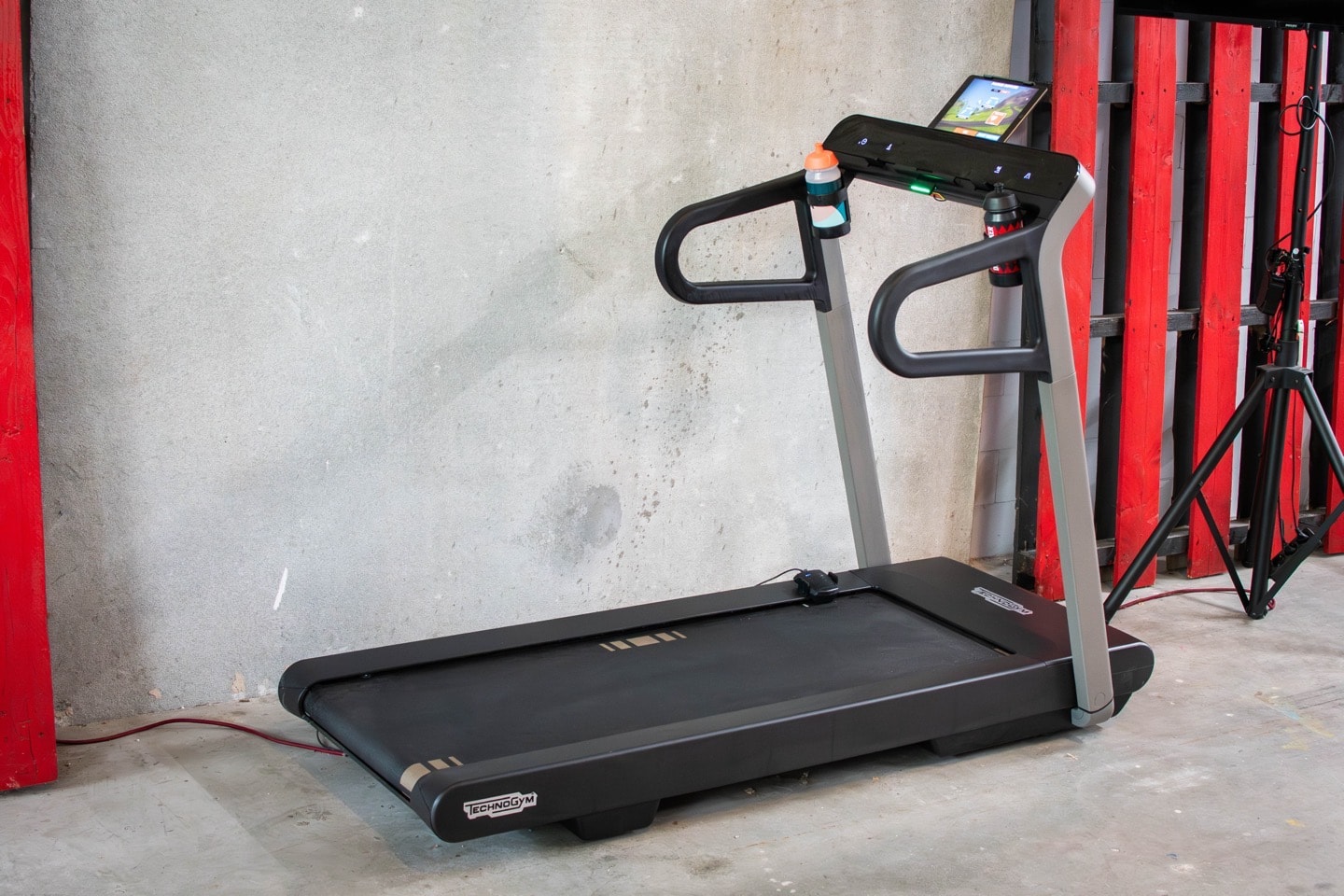
The Technogym MyRun treadmill has been around for over 5 years now, yet despite its age, it continues to be a popular option people are considering for usage with Zwift and other indoor running platforms. As such, the MyRun has been floating around the DCR Cave for about 18 months. Both myself and my wife have put a number of miles on it, giving us a pretty solid feel for how well it works – and some of the catches.
The main unique feature of the MyRun treadmill is largely its solid connectivity to apps like Zwift via Bluetooth Smart, or platforms like TrainingPeaks (structured workouts) and Strava (re-creating your outdoor runs, inside, 3D worlds and all). In fact, back years ago when Zwift first launched Zwift Running, they did so at a launch event in New York City packed with Technogym MyRun treadmills.
The secondary aspect that’s most notable is just how minimalist the treadmill is. Of course, as you’ll see that has both benefits and drawbacks. While it’ll fit into the sleekest of garages, it means you sacrifice quick-access type buttons found on many treadmills for instantly changing pace to specific values. Point is, there’s always tradeoffs to be had – and hopefully, in this review you can figure out whether or not those tradeoffs make sense to you.
Finally, note that Technogym provided a media loaner Technogym MyRun to test. In fact, it already shipped back to them last week. If you found this review useful, you can use the links at the bottom, or consider becoming a DCR Supporter which makes the site ad-free, while also getting access to a mostly weekly video series behind the scenes of the DCR Cave. And of course, it makes you awesome.
In The Box/Delivery:

Like most home gym equipment, how precisely things get delivered depends on your exact region. In my case, it meant that two dudes and a truck offloaded the treadmill, and in a matter of minutes assembled it. It turns out they get special training on how to assemble all manner of devices, from Technogym treadmills like this (as well as the Technogym Ride smart bike they assembled that same day) to e-bike battery installation systems. You can see the treadmill set of boxes on the right of the truck:

Essentially a certified handyman who also drives a big truck, and not specific to Technogym. You can see the boxes here on the pallet. Essentially it’s just attaching the main console section:

The other guy was upstairs working on the bike and I was watching him, and turned around a few minutes later and the guy downstairs was done.

In any event, like I said, the whole thing basically consisted of them attaching the upper console portion. It was well under 15 minutes and very efficient. Sadly, I don’t have too much in the way of photos of that. Also, it’s kinda awkward taking pictures of people doing their jobs.
The Hardware:
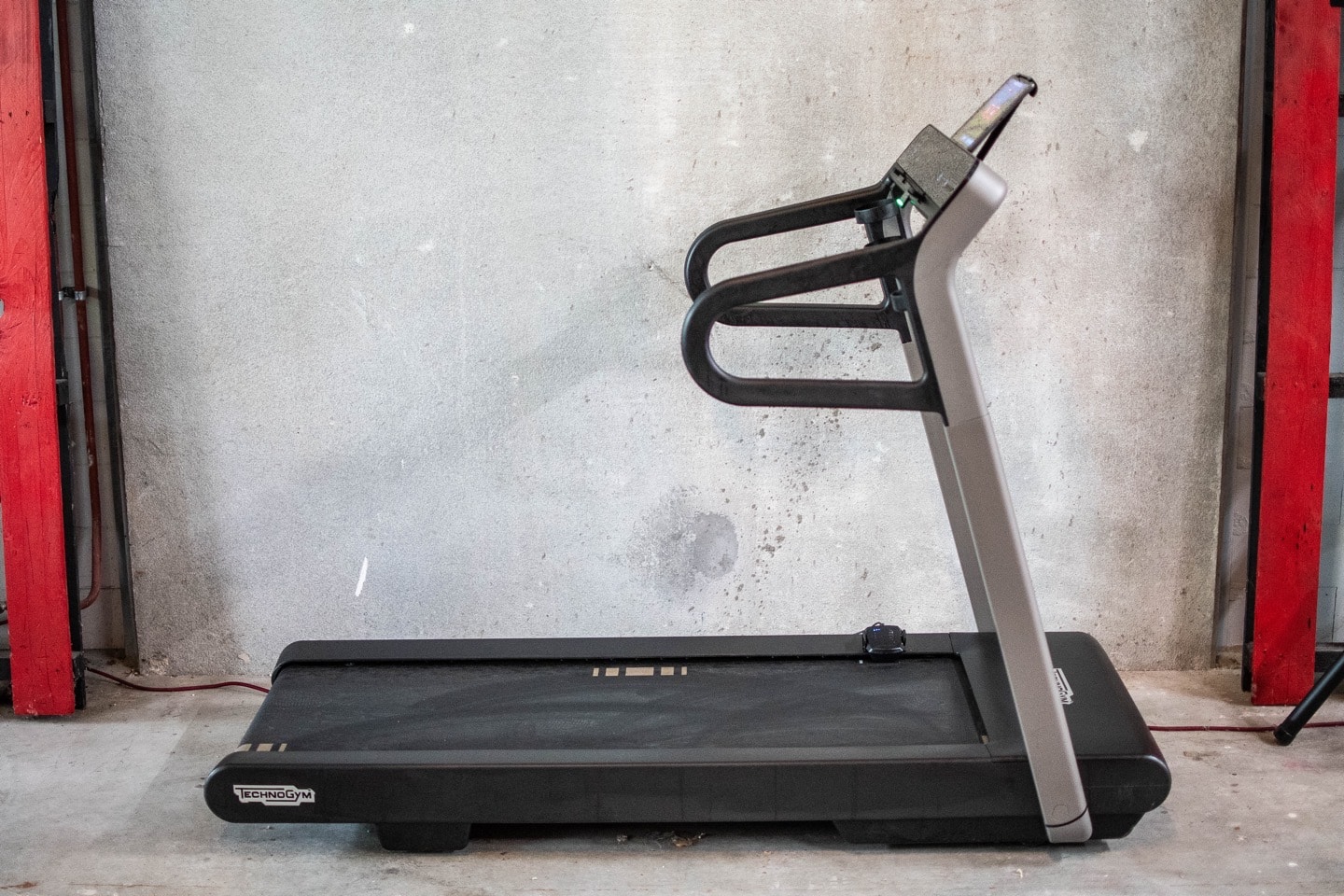
So, let’s start with a quick look at the hardware side of things first, before I dive into the usage aspects of it. From an overall treadmill size perspective, the actual belt isn’t that much different than other treadmills. Instead, what differs is the lack of an overbearing console up top (which often have a larger display). This lacks all of that, and thus feels smaller, as it’s vertically not a beast. The tablet you see up top there isn’t part of the unit, but rather just an iPad.
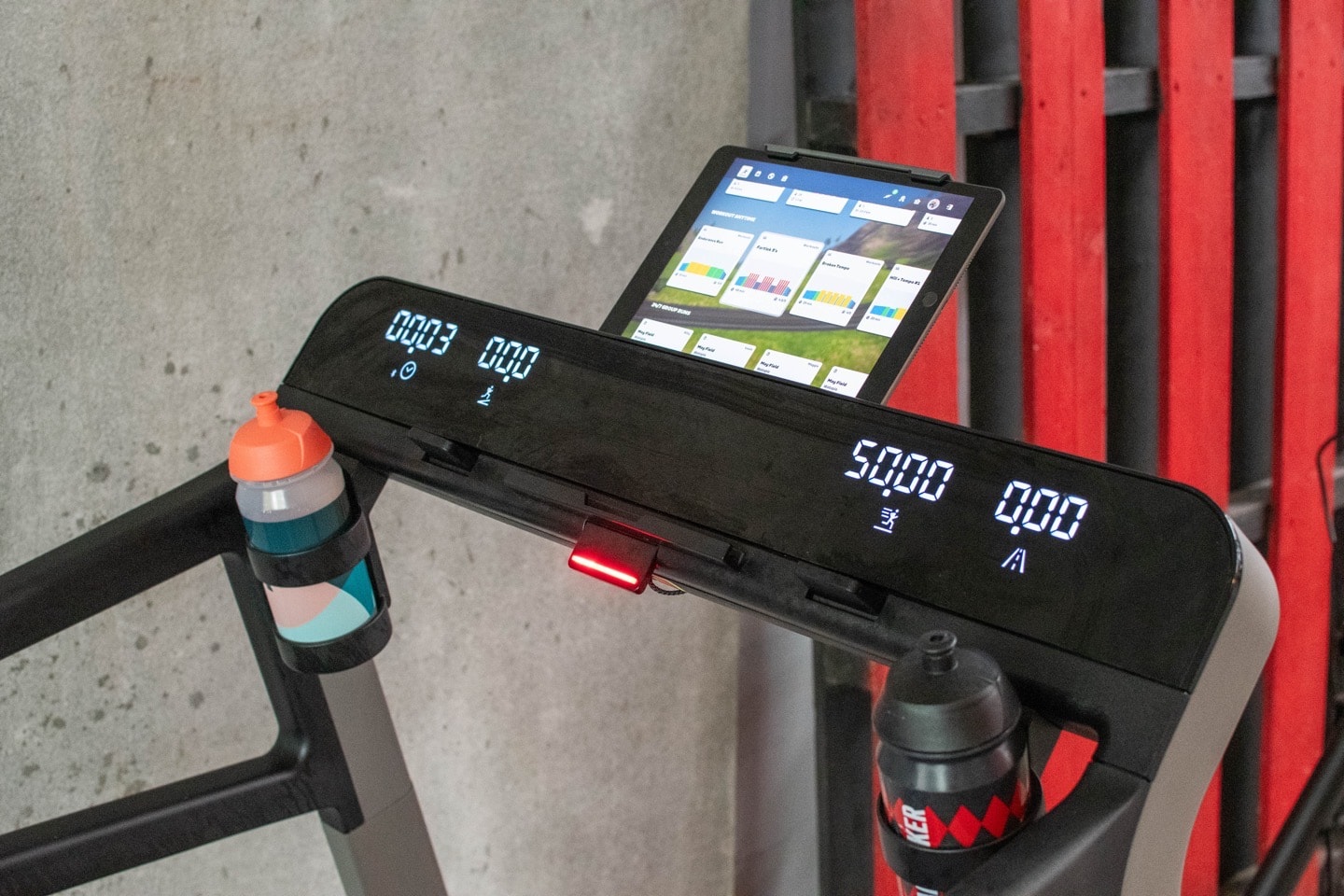
The unit measures 69” long x 31” wide x 50” high (176cm long x 78.5cm wide x 126cm high), and weighs 202.8 pounds (92kg). This is a heck of a lot lighter than my Peloton Tread, which weighs 290lbs/132kg. And also smaller in every dimension.
The maximum permitted runner weight on the Technogym MyRun is listed as 308.6lbs/140kg. Technogym doesn’t appear to specify an ideal runner height (or, ideal for the treadmill anyway). In my case, I’m 6’2” (188cm) tall, and as I’ll outline in more detail later, I had no problems with it (sometimes for taller people, you want a longer belt – the runnable surface of this belt measures 143cm/56.3” long, and 50cm/19.7” wide.

(The small pod you see in the upper left corner is the NPE RUNN, this is not part of the Technogym MyRun treadmill, but rather an accessory I use to validate accuracy of said treadmill.)
There is no folding or otherwise for the treadmill to save space. Some treadmills can also bend up against a wall or such, this doesn’t do that either. It has wheels on the front, to move it around, which I did from time to time.
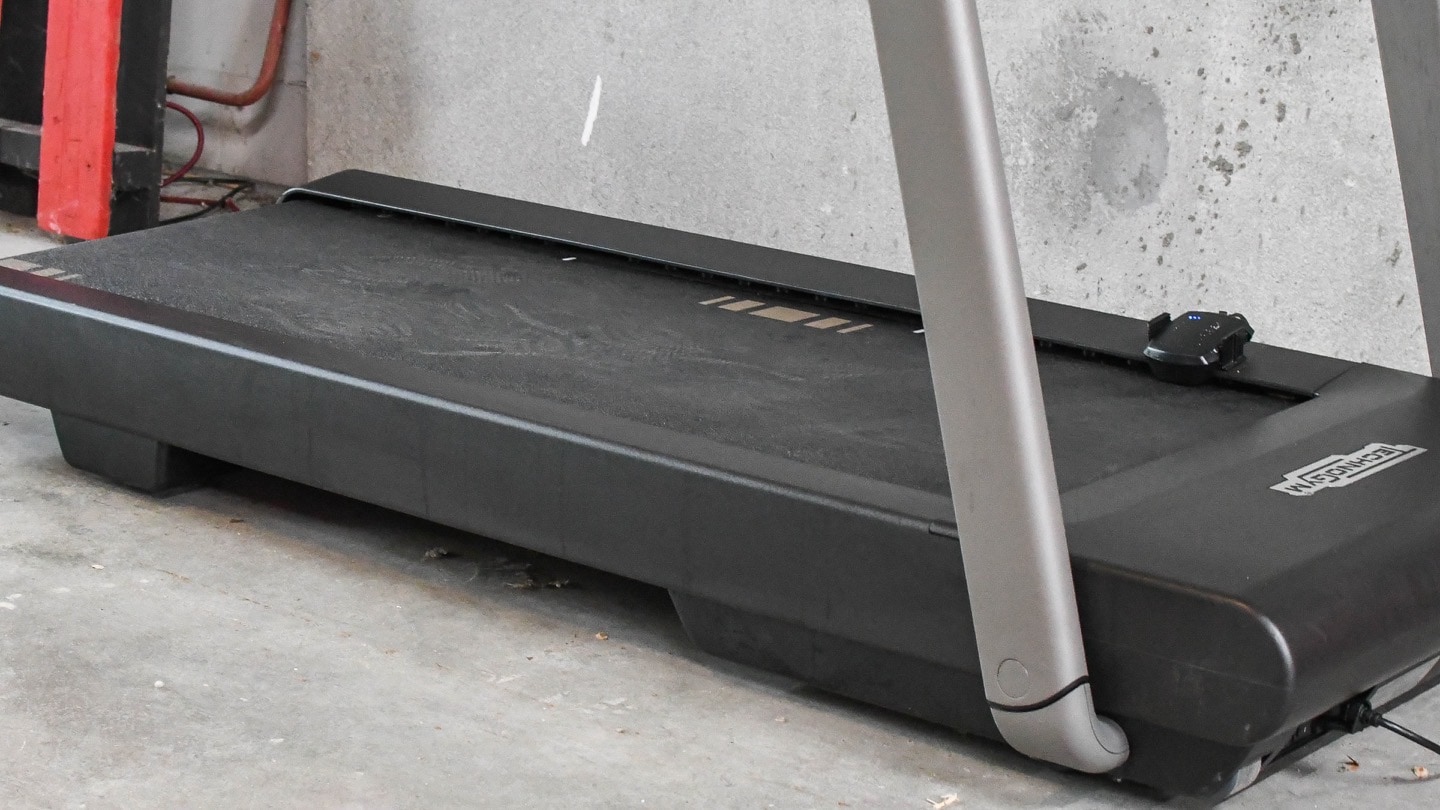
From a speed/specs standpoint, the treadmill goes up to a max speed of 12.5MPH/20.0KPH (4:48/mile or 3:00/KM). Again, as I’ll cover later on in more detail, if you’re not familiar with running that much – then that’s more than enough. If you’re a rather fast runner that’s specifically training for shorter distances (e.g., 400m races), then it might not be enough for what you need. But I think that’s a very very very rare slice of the population.
From an incline standpoint, it tops out at 12%. There is no negative decline. Here’s a quick shot of it at 0% incline, and then at 12% incline. You can see the front legs/wheels extending downwards to hold it up:
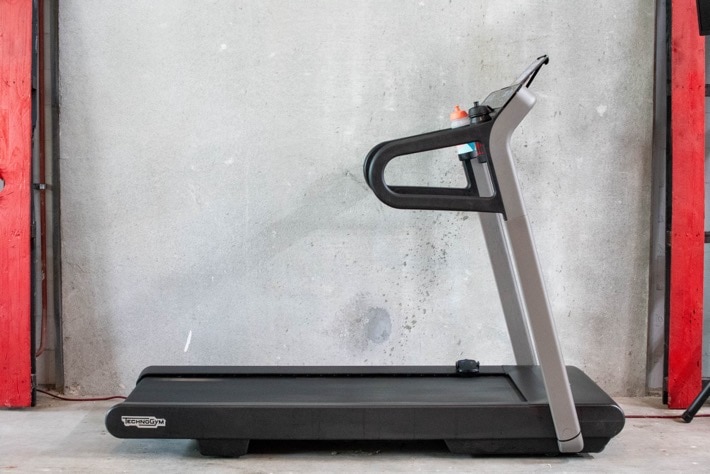
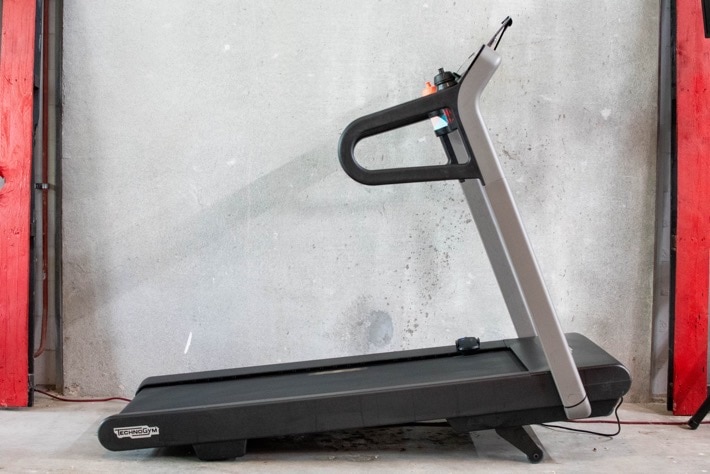
The unit’s console displays speed/distance/time/incline, and has Bluetooth connectivity (via Bluetooth FTMS). It does not have WiFI, nor ANT+ connectivity. Nor does it have any sort of speakers. It does however, have two water bottle holders. Further, the side handles are capable of holding many watches.

And it seems reasonably sweat-resistant. Both myself and my wife have sweated all over it, and even put it into a heat acclimation chamber for a month (airing it out after each run), and seems totally fine.
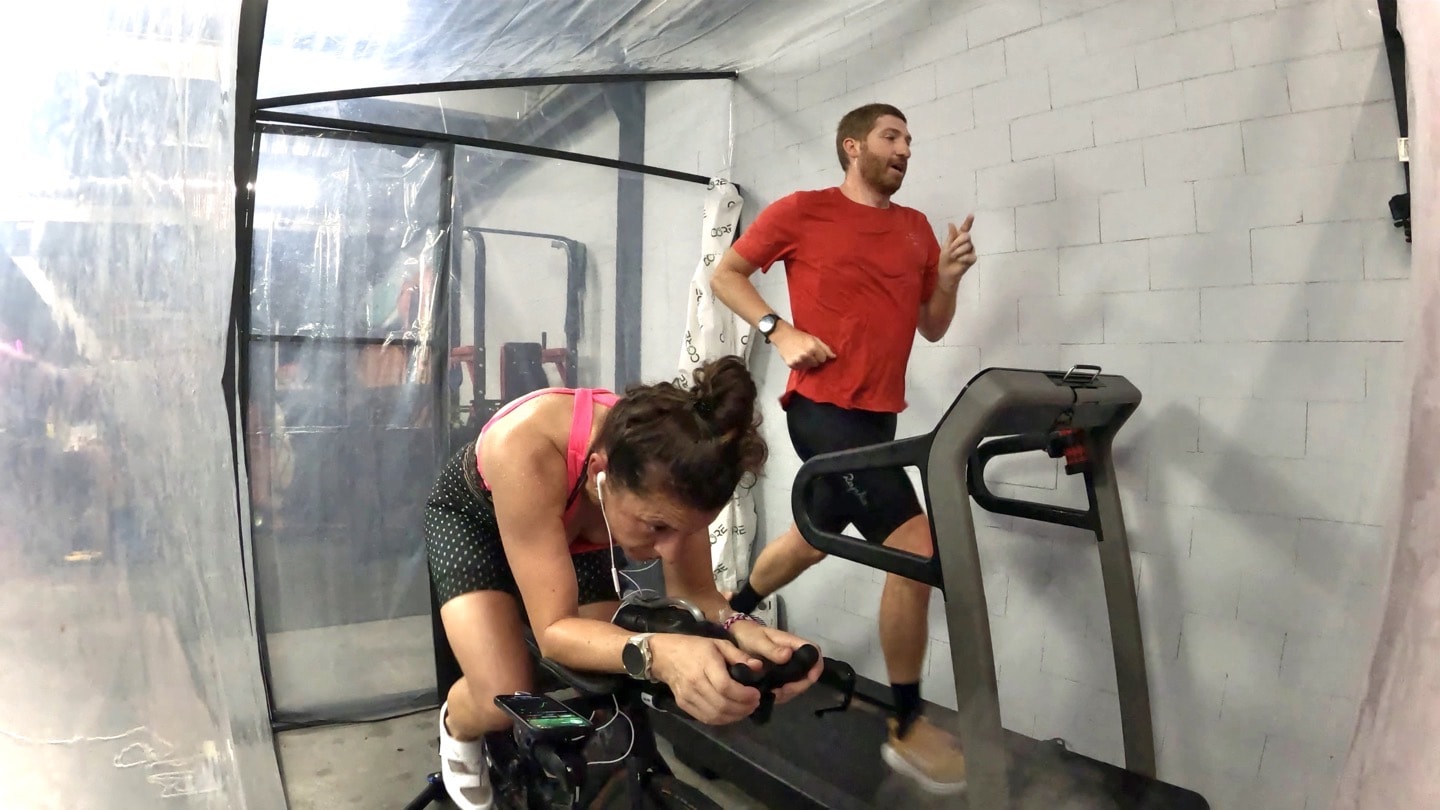
Finally, the hardware has a small safety strap/magnet on the bottom that you can pretend to wear, which will stop the treadmill if you fly off the back.
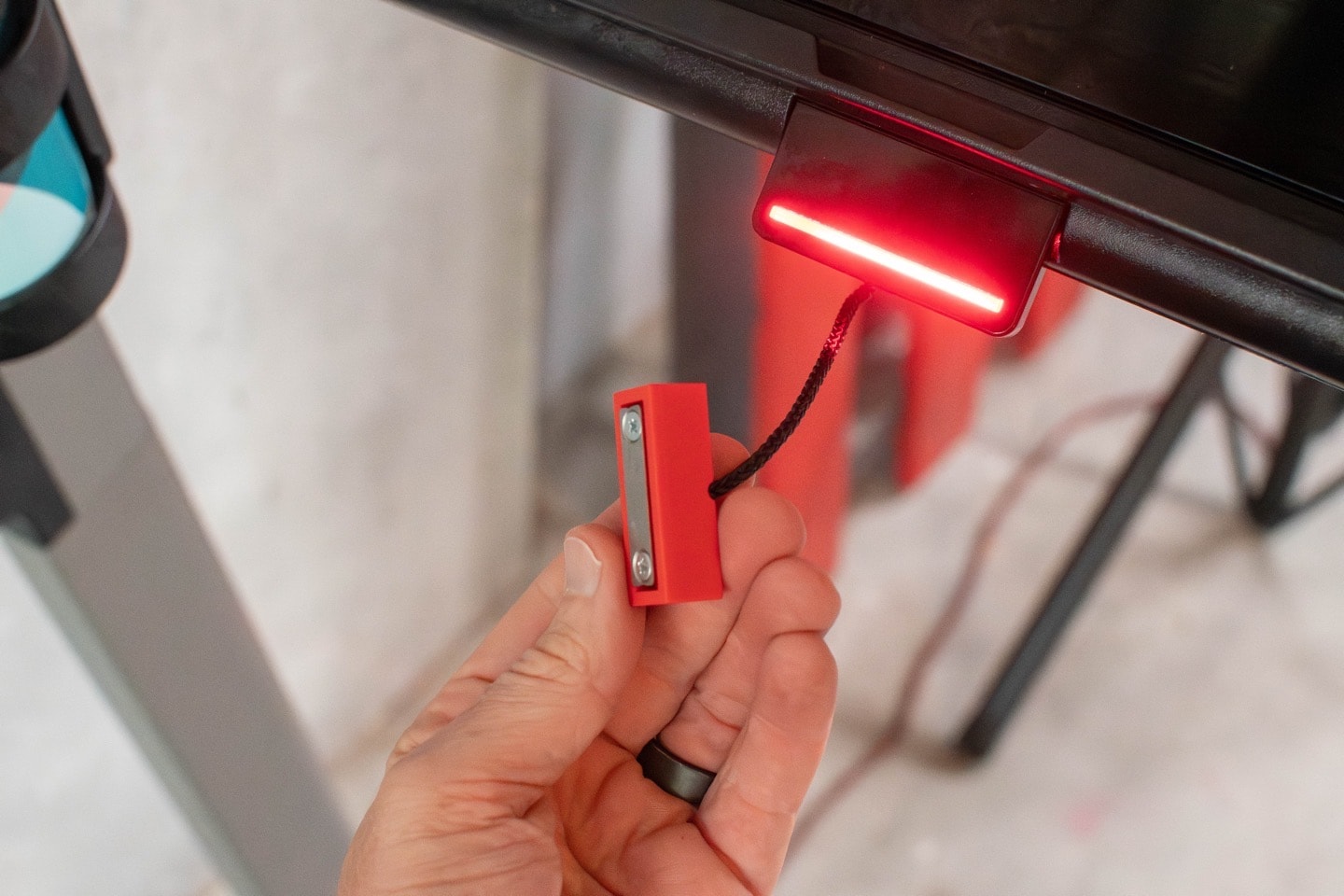
Obviously, you and I both know you’re not going to wear that. But, there is value in removing it if you have smaller humans around the house, to ensure they can’t start the treadmill without it.
With that, let’s talk about things we’ve actually used.
Regular Usage:

It’s always interesting to me to see how two different athletes train. In the case of myself and my wife, we’ve used the treadmill in rather different ways. Sure, we both run on it roughly the same way (her, gracefully…me, not so much) – but we use different apps/features. In her case, for probably 98.5% of her runs, she’s just used it in standalone mode, with no app control/integration. Not even pairing it to her watch for more accurate pace/distance data. She just prefers to hammer out her workouts using the controls on the console
Inversely, in my case, I’ve almost always run on it with Zwift. There’s been a handful of cases otherwise where I’ve used the Technogym Live app (more on that later), but in almost all my runs I’ve linked it up to Zwift to get speed/distance within Zwift and control my virtual avatar there.
Starting off with the more basic usage first though, is simply getting on the treadmill and starting it. You’ll tap really any of the levers/buttons to wake it up, if it’s fallen asleep. And then from there you’ll tap the lower-middle lever to start the actual treadmill belt:
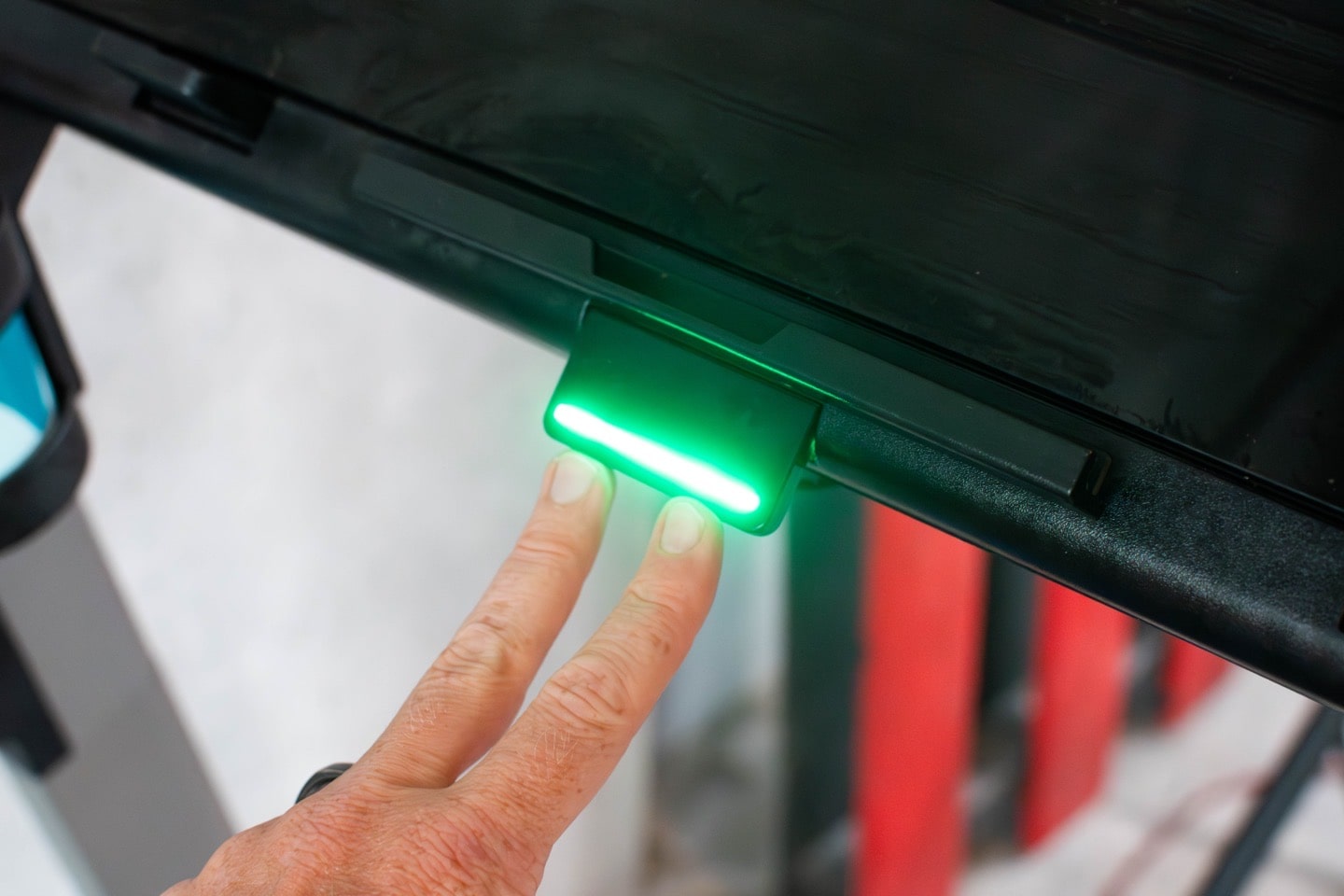
At this point you’ve got two core controls here:
A) Left side paddle for increasing/decreasing incline
B) Right side paddle for increasing/decreasing speed
Here’s the left side:
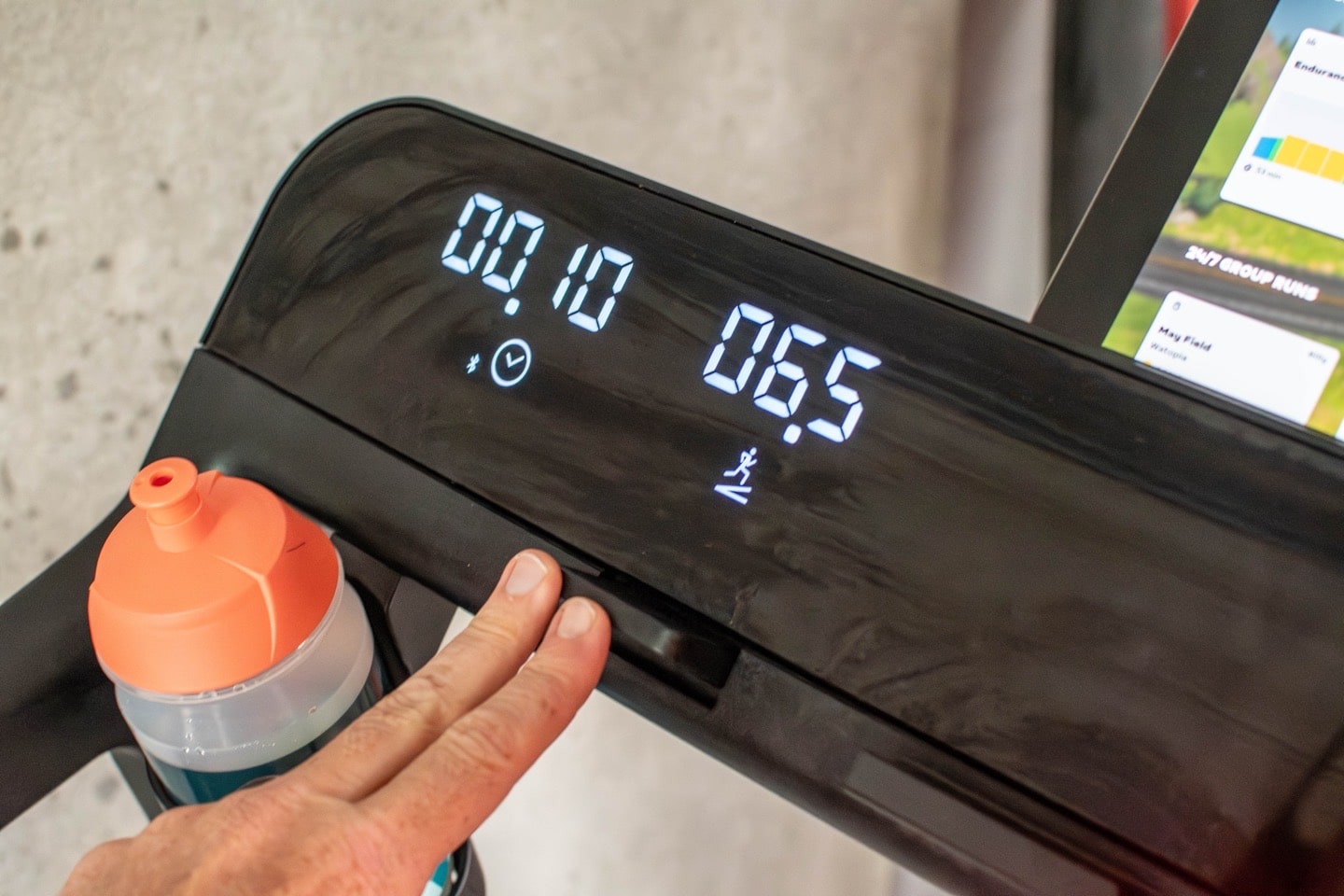
And then here’s the right side:

In addition, that middle paddle/lever for instantly stopping the treadmill (or, resuming it again). And…that’s it. There are no other controls on the treadmill. Instead, just data screens you can look at. These are:
A) Far left screen: Timer
B) Middle left screen: Current incline
C) Middle right screen: Speed
D) Far right screen: Distance
When it comes to this data, none of it is customizable. Also, it won’t directly sync 3rd party apps. For example, if you start a simple run as a warm-up in Zwift, perhaps do 10 minutes, and then start a new route/course in Zwift, you’ll have a Zwift distance/timer that doesn’t match your treadmill distance/timer. This hasn’t really been a big issue for me, but figured I’d mention it.
So when I look at treadmills there’s a few core things I’m looking at. Certainly, top-end speed is one of those things. At 12.5MPH/20KPH, this is pretty much the norm for most mid-range treadmills. For perspective, this equates to a pace of 4:48/mi pace, or a 3:00/km pace. Mildly cruising.
Some higher-end ones can go higher, but practically speaking unless you’re a short-distance runner (e.g. training for 800m races), then you won’t likely need to be doing a ton of very short and fast bits. Whereas for most of my training with intervals, about the fastest I’m doing anything sustained is down to the 3:00/km (4:48/mi) pace. Granted, the shortest distance of race I train for tends to be half-marathon – but I suspect this is fast enough for most people. Note that I’ll cover speed responsiveness in the accuracy section.

Then finally, there’s aspects around the belt. How does the belt feel (including length), and what’s the sound/noise levels like.
From a belt feel standpoint, I didn’t find it too firm or too squishy. Perhaps some people are more particular than I, but I was totally fine with the belt bounce/feel. Whereas I actually don’t particularly like running on fancier/higher-end slat-based treadmills, as it just doesn’t feel right to me (this is a belt-based treadmill, so that’s all good in my book). Further, this belt length is often seen as perhaps a touch bit short at 143cm/56.3” long. Certainly, that’s because Technogym is likely trying to keep it smaller for smaller spaces. Again, even as a relatively tall guy at 6’ 2” (188cm) – I simply didn’t have any issues here.

Likewise, my wife, shorter at 5’2” (157cm) certainly didn’t have any issues with the treadmill belt either. Sorry, this photo was taken through the plastic film of the heat acclimation chamber I made. Thus, it kinda has an Instagram filter vibe to it.
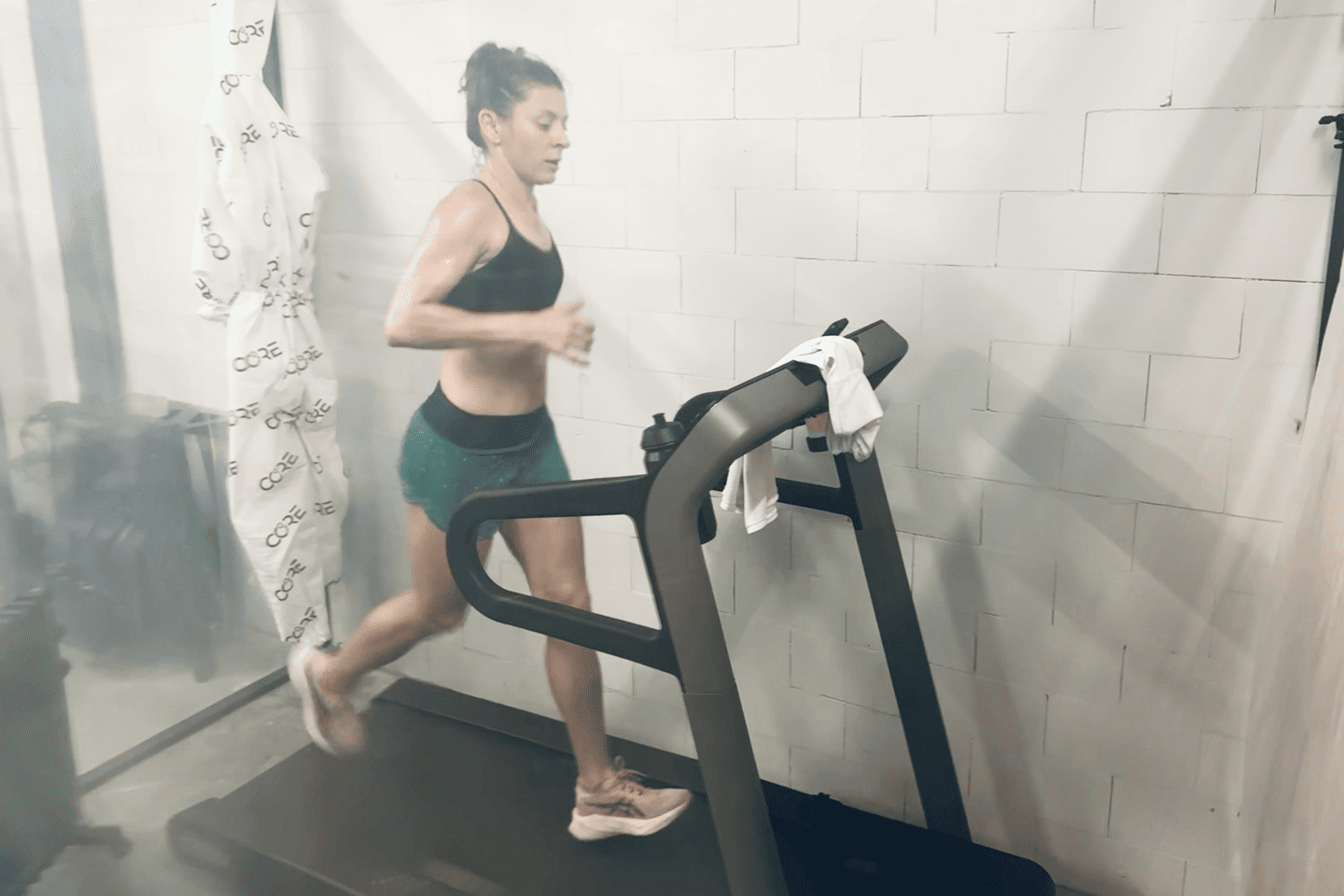
Sure, every once in a while towards the end of a tough set of intervals I’d find myself drifting dangerously close to the back of the treadmill, but such is life on almost any treadmill. Get tired enough, and you’ll probably flirt with disaster at some point.
While the Technogym treadmill does have an area in front of the belt that is not belt (where the motors and such are presumably sitting), I didn’t have any issues clipping it while running. Sometimes I’ll clip that on treadmills that’ll have a beefier front end, but the Technogym is pretty thin in that area (depth-wise, and even tapers closer to the belt), so it wasn’t a problem for me.
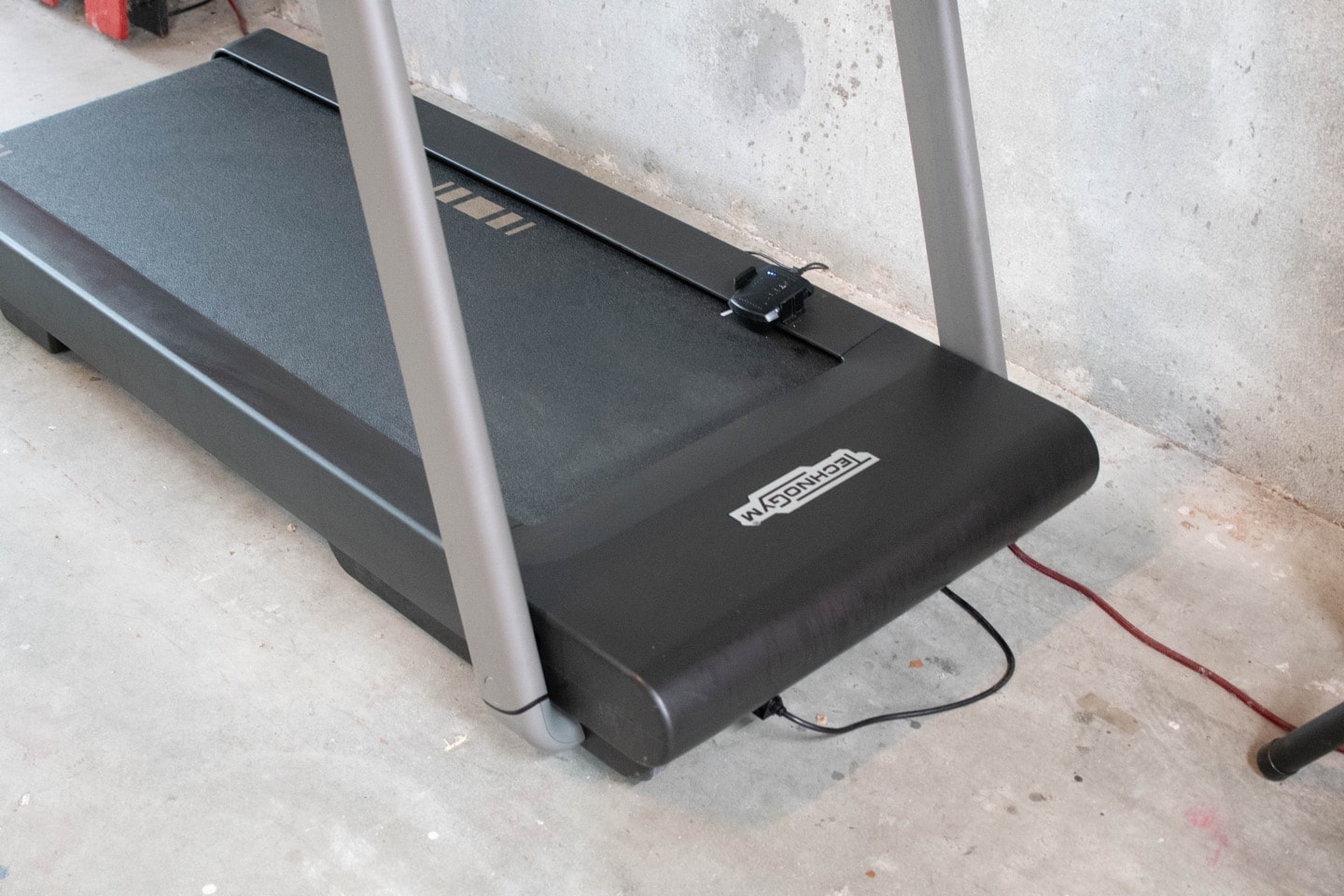
Finally, on the noise side of life, that’s a bit trickier. The treadmill sits in the lower portion of the DCR Cave, which is basically just a giant concrete warehouse. It’s the worst possible scenario for noise, thus, I don’t really have a good way to measure that down here unfortunately. It’s certainly not quiet, that’s for sure. But it’s also not the loudest possible treadmill I’ve heard either. It’s just…well…normal sounding?
Look, I can tell you about lots of things, but in terms of noise on this one, that’s the one area I lack: A proper living room with family members trying to watch a TV show while I run intervals. I suspect someone in the comments has instead unlocked that achievement, and can offer some perspective.
App Integration:
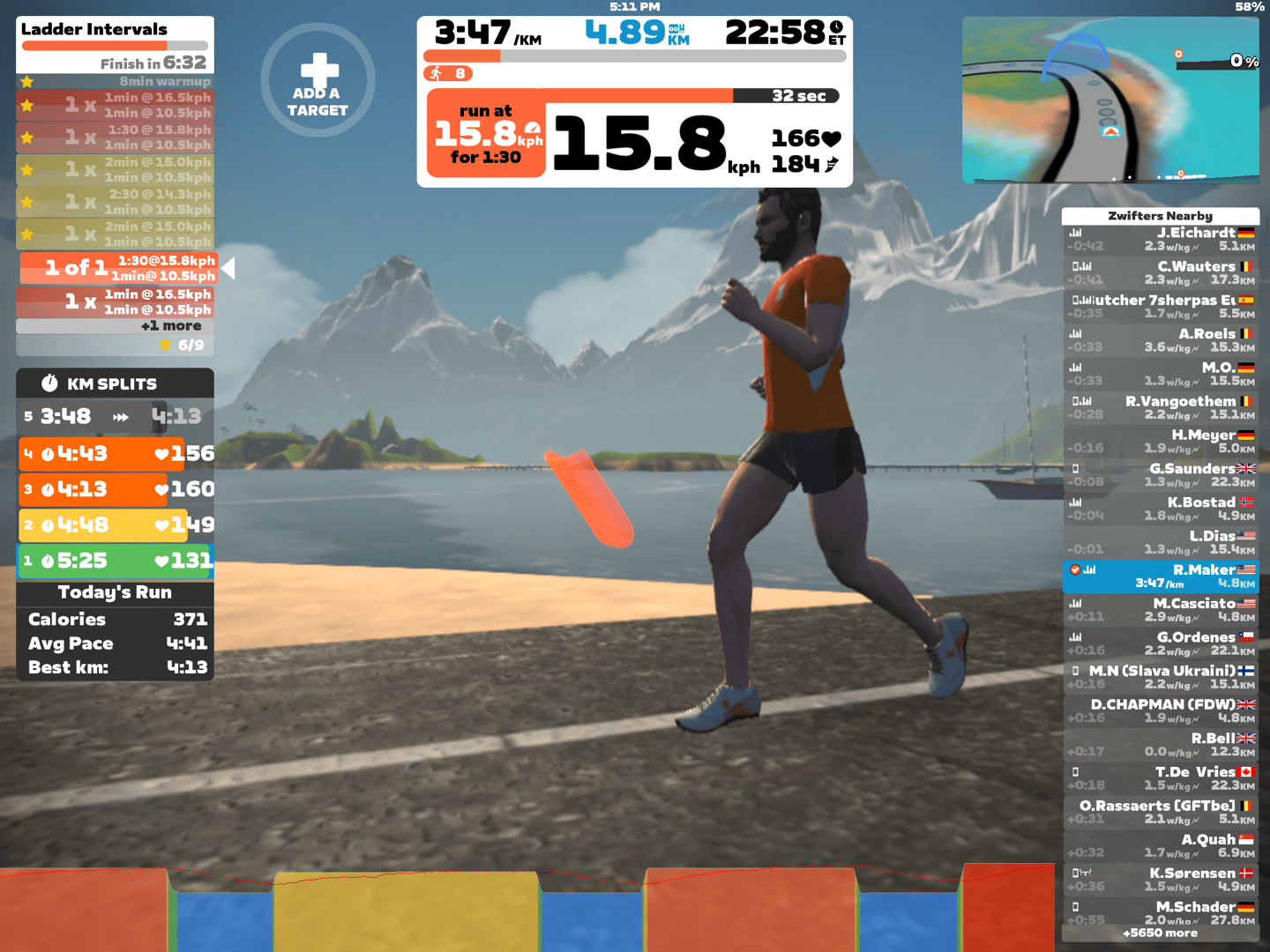
When it comes to connectivity and apps, there are basically two rough categories here:
A) The flotilla of Technogym apps
B) 3rd party apps (via open standards)
For the Technogym apps, there are indeed, many apps. I honestly can’t keep track of all of them, but they do have specific purposes. For example, the Technogym app (literally titled ‘Technogym’) on my phone will show my completed workouts and other workouts I can do with a heart rate sensor. But, it will not connect to the treadmill. For that, I need the Technogym Live app, which does not run on the phone, but only on my iPad and computer. Except, it crashes every time I tap the ‘Settings’ button for the treadmill in the app on my computer. Thus, I’m ultimately left with only the Technogym Live app on my iPad as functional.
This app lets you do structured workouts, both ones created by Technogym as well as those that you’ve created. Further, if you’ve got TrainingPeaks linked as an account, it’ll even iterate through those workouts (including changing pace/distance).
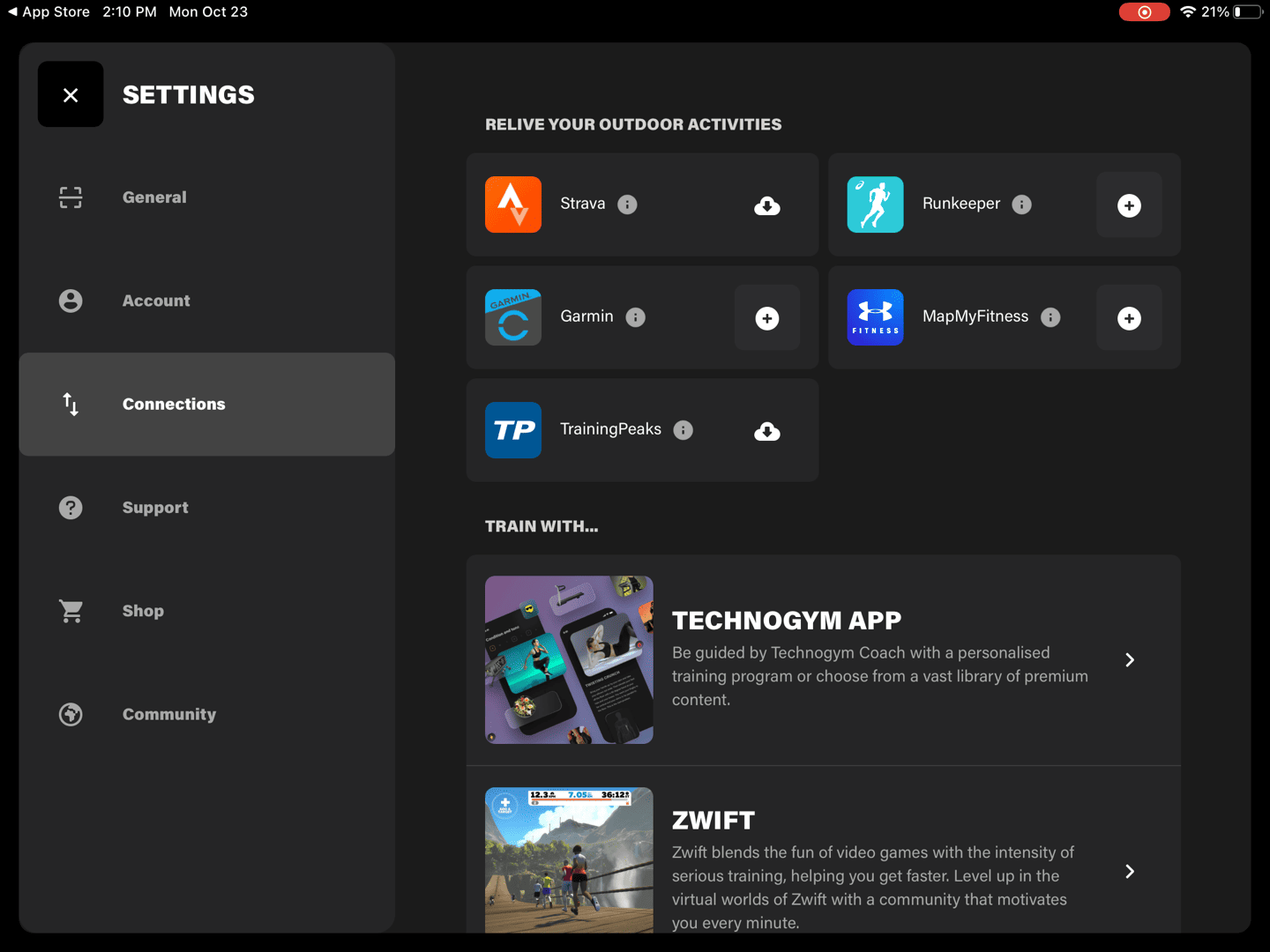
Likewise, for Strava, it’ll even pull in my outdoor runs and automatically control the treadmill (yes, pace AND incline) to match exactly what I did outside, showing me a little Google Earth map of it as I go along. It’s not quite to street-view level (as in, ground-level), but it is on an angle and gives me the general feel of the area I’m running in (albeit, within the limitations of Google’s data set, thus here it shows more of a leaf-less winter feel, than the green or fall leaves I was running). Still, it’s cool.
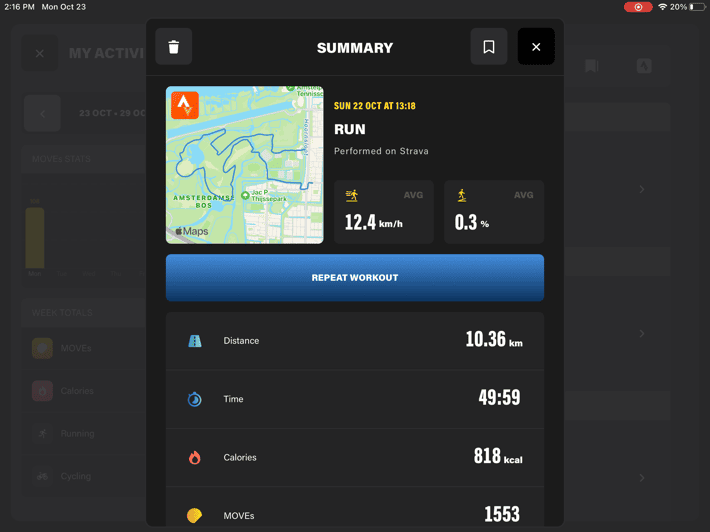
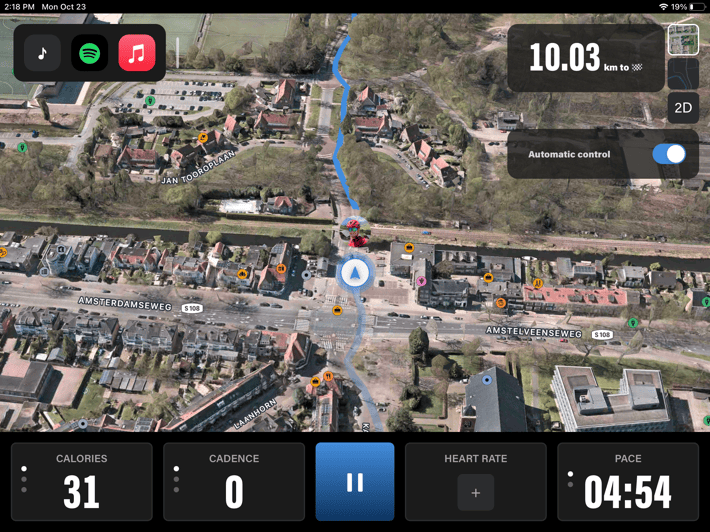
But they’ve also got a number of their own workout components as well. These include structured workouts, coached workouts, scenic runs in a variety of spots, and non-running workouts.
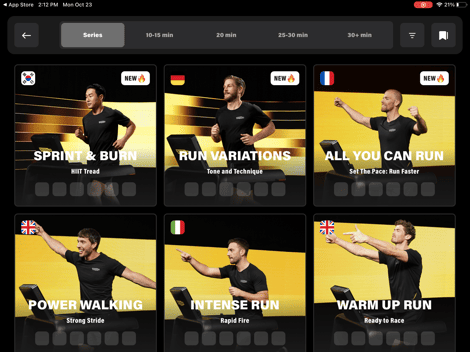
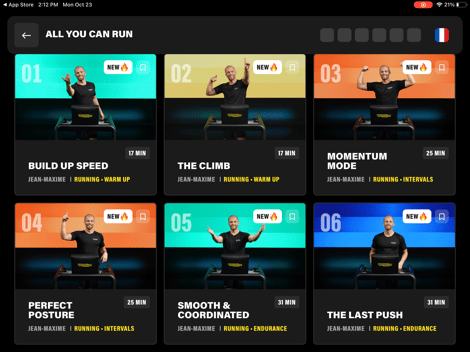

For example on the scenic runs, there’s plenty of different locales and terrain types to choose from – all there to remind you that you’re stuck inside on a treadmill.
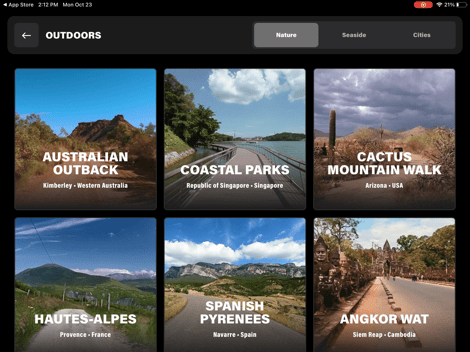
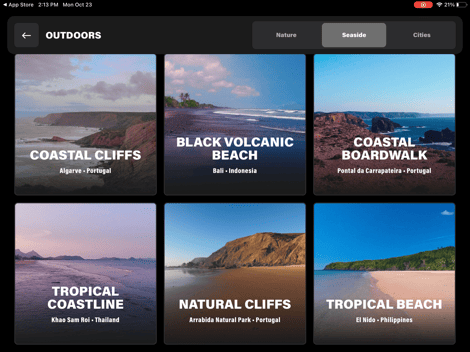
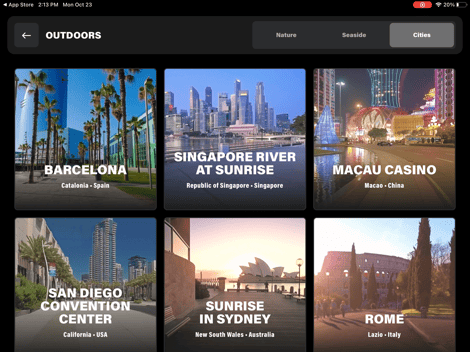
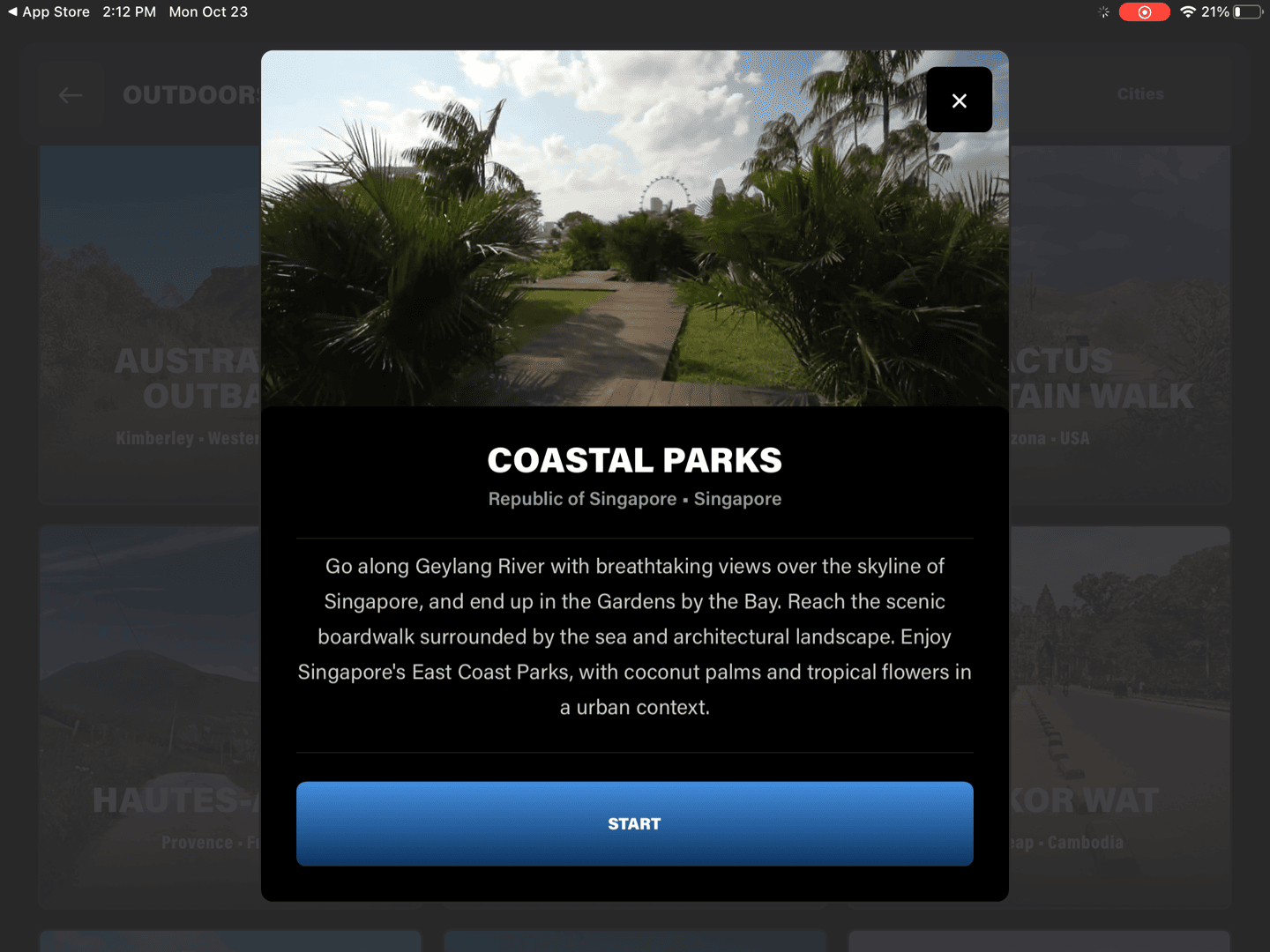
Within that app you can also create your own structured workouts in the Technogym app (as opposed to via TrainingPeaks):
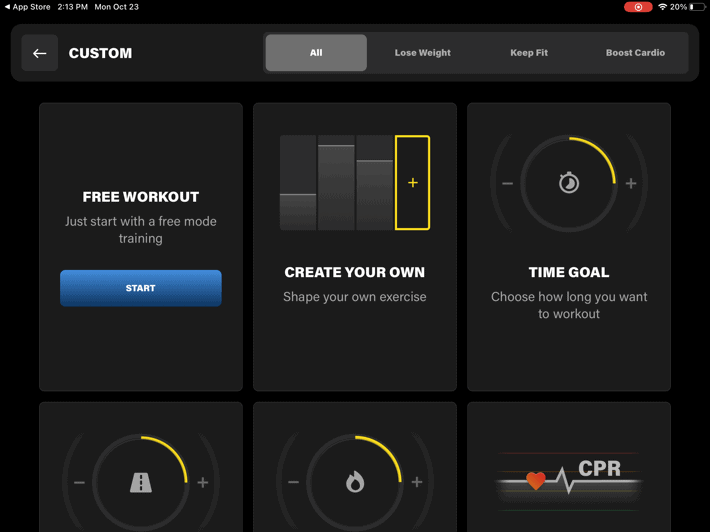

However, that process for truly custom workouts is a nightmare for interval workouts. That’s because each (AND EVERY @#$*U#) segment has to be created individually (with no repeat type option), and more annoyingly, the sliders to set each pace/distance/time/etc are incredibly sensitive, so getting the exact distances you want (e.g., 800m) or exact paces you want (e.g., 4:00/km) is mind-bogglingly difficult with your finger, given the vast expanse of possibilities.

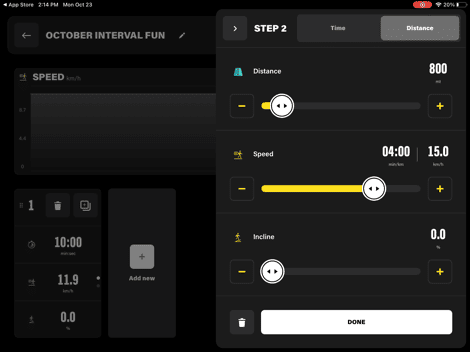
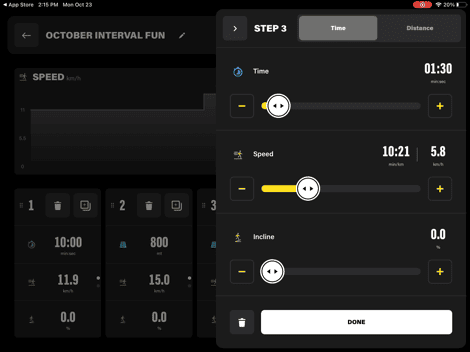
Seriously, if someone from Technogym is listening (and, I know you are), whoever made this UI needs to be sat down in a room, given 15 structured interval workouts, and made to try and input them into the app. I guarantee you that when you check on the state of that person after 15-20 minutes, they’ll be gone. Either they’ll have quit the company entirely, or they’ll be back at their desk fixing it. I refuse to believe anyone has ever actually tried creating a custom workout this way.
Otherwise, the app is a place to check settings and update firmware on the Technogym MyRun. Again, you can’t do that from the phone app – which seems kinda silly to me.
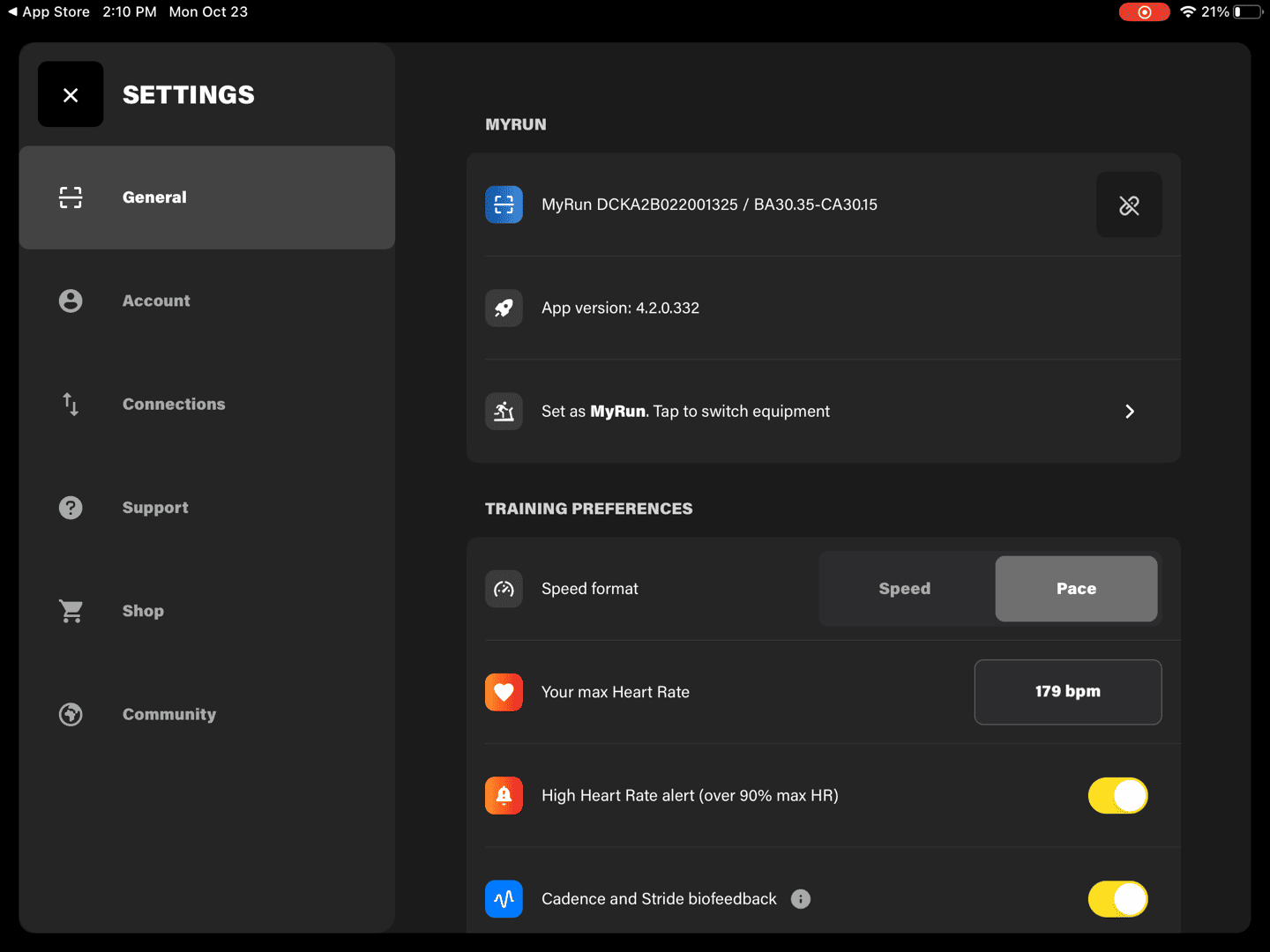
In any event, when it comes to control of the treadmill, as I mentioned, you can use the built-in Technogym Live functionality, including changing pace and incline with TrainingPeaks workouts. However, that functionality isn’t available with Zwift. Technogym says that’s been offered to Zwift, but they haven’t taken advantage of that opportunity. Like most treadmill companies, there are a lot of security/safety controls when it comes to allowing 3rd party apps to control a treadmill (primarily speed), as you can imagine a case where an app incorrectly and instantly sets the treadmill to max speed, resulting in someone flying off the back.
In Technogym’s case, they have a specific certification process for apps that request control, but alas, Zwift hasn’t taken advantage of that. So instead, let’s talk about what Zwift can do.
The Technogym MyRun transmits across just Bluetooth Smart, and specifically Bluetooth Smart FTMS. This makes it very compatible with apps like Zwift, and most Garmin watches. But not quite as compatible as Technogym should have made it. Specifically, it lacks the Bluetooth Smart footpod profile, which would have made it easier for other apps and even watches to connect to. For example, neither the Polar nor Suunto watch I’ve been testing lately can connect to it, because they don’t support Bluetooth Smart FTMS (but do support Bluetooth footpods). But, Zwift can via FTMS, because it’s the same protocol smart trainers use:
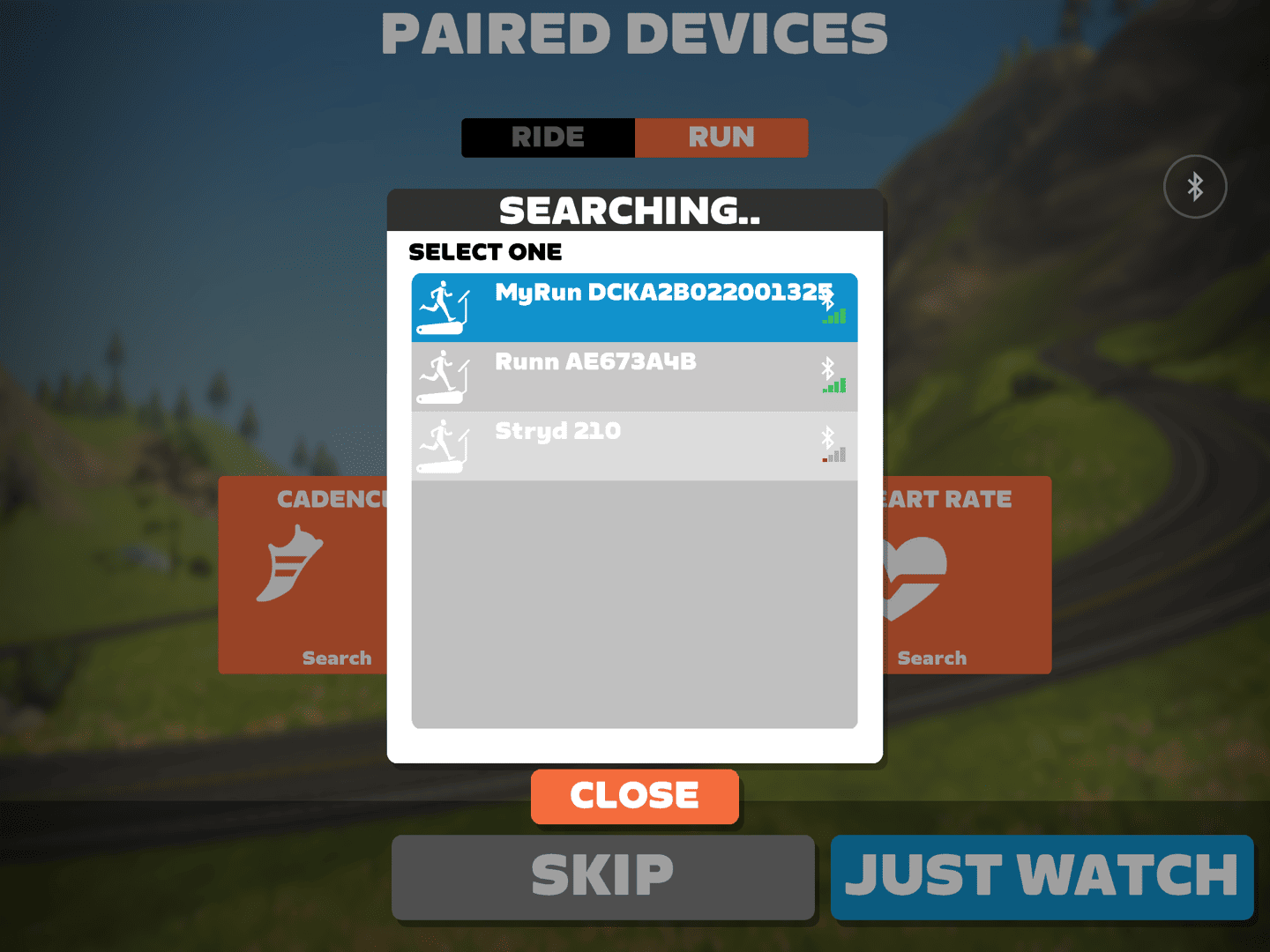
Inside of Zwift, you’ll connect to both the running speed and cadence portions, and even heart rate if you’ve configured that to pass it through. In my case, I largely just used another strap:
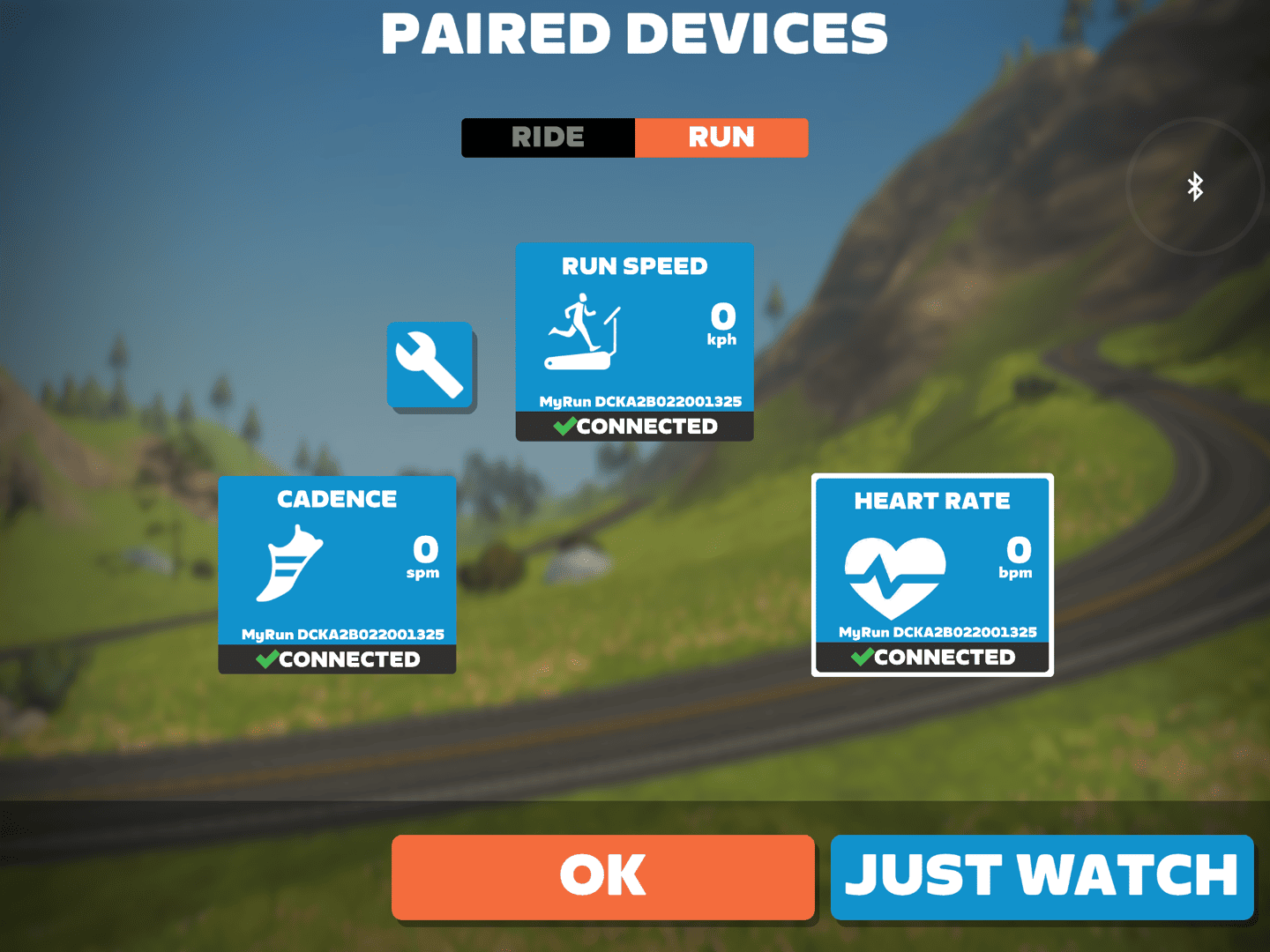
At that point, that’s all you need to do. Next, you start whichever course/route/etc on Zwift you want to, and then off you go. It’ll transmit your pace to Zwift, which in turn Zwift calculates to distance. It’ll also send cadence as well.
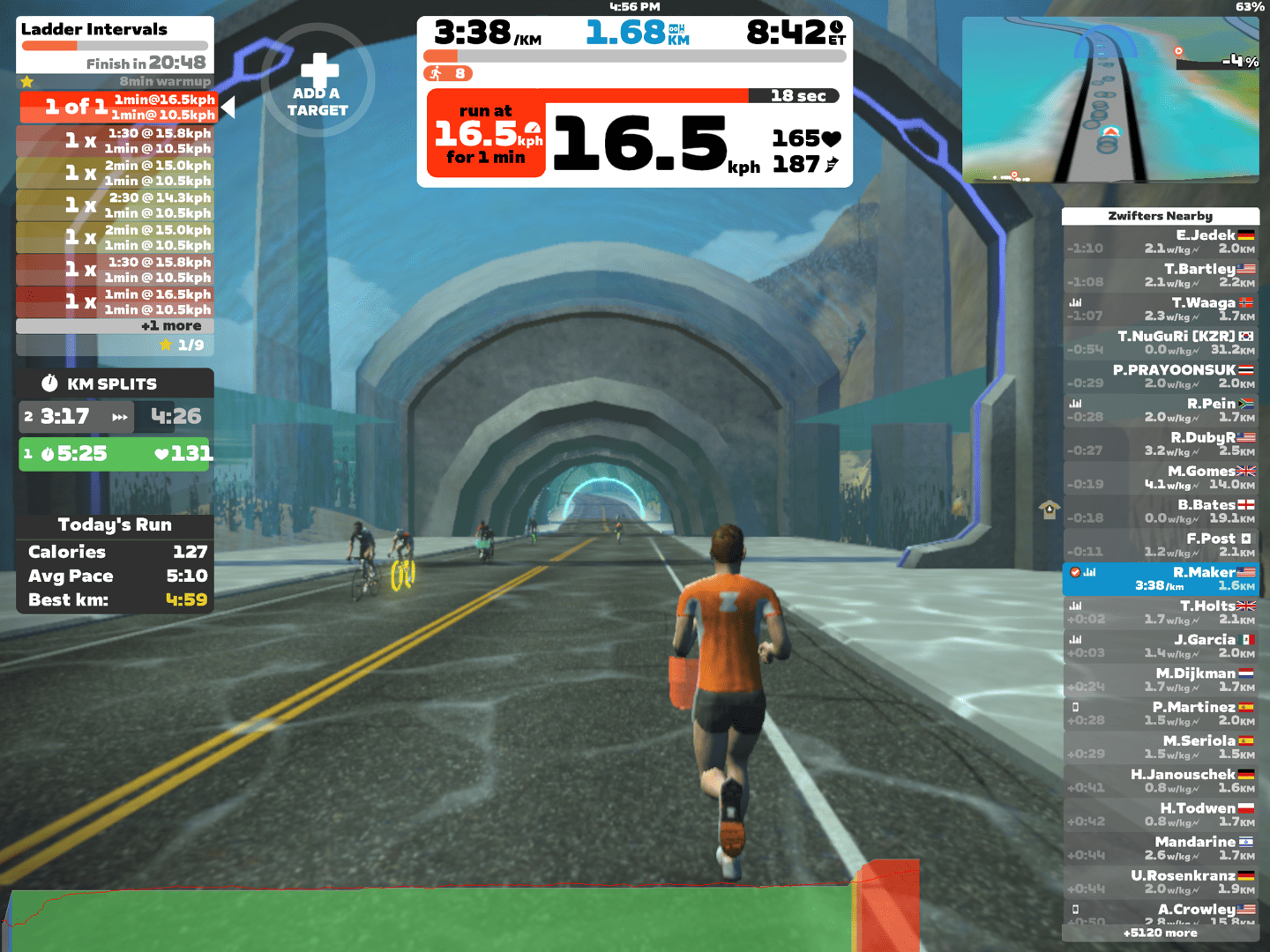
It’s super important to note that Zwift will not change the incline on the treadmill, nor will Zwift change the pace if doing a structured workout. Both are things you’ll need to change yourself manually. In talking to Technogym, they say this is something that they’re very open to integrating with Zwift, but at the moment that ball is in Zwift’s court.
This integration would require validation by Technogym, merely due to the risks associated with 3rd parties controlling pace on a treadmill (most companies are very hesitant of allowing any 3rd party apps to control pace or incline, but Technogym says they have a certification process in place to do so, but Zwift hasn’t leveraged it yet). Thus for example in this structured workout, I needed to manually change each of the steps as I ran along (whereas, if done within the Technogym app as a TrainingPeaks workout, it would have done it for me).
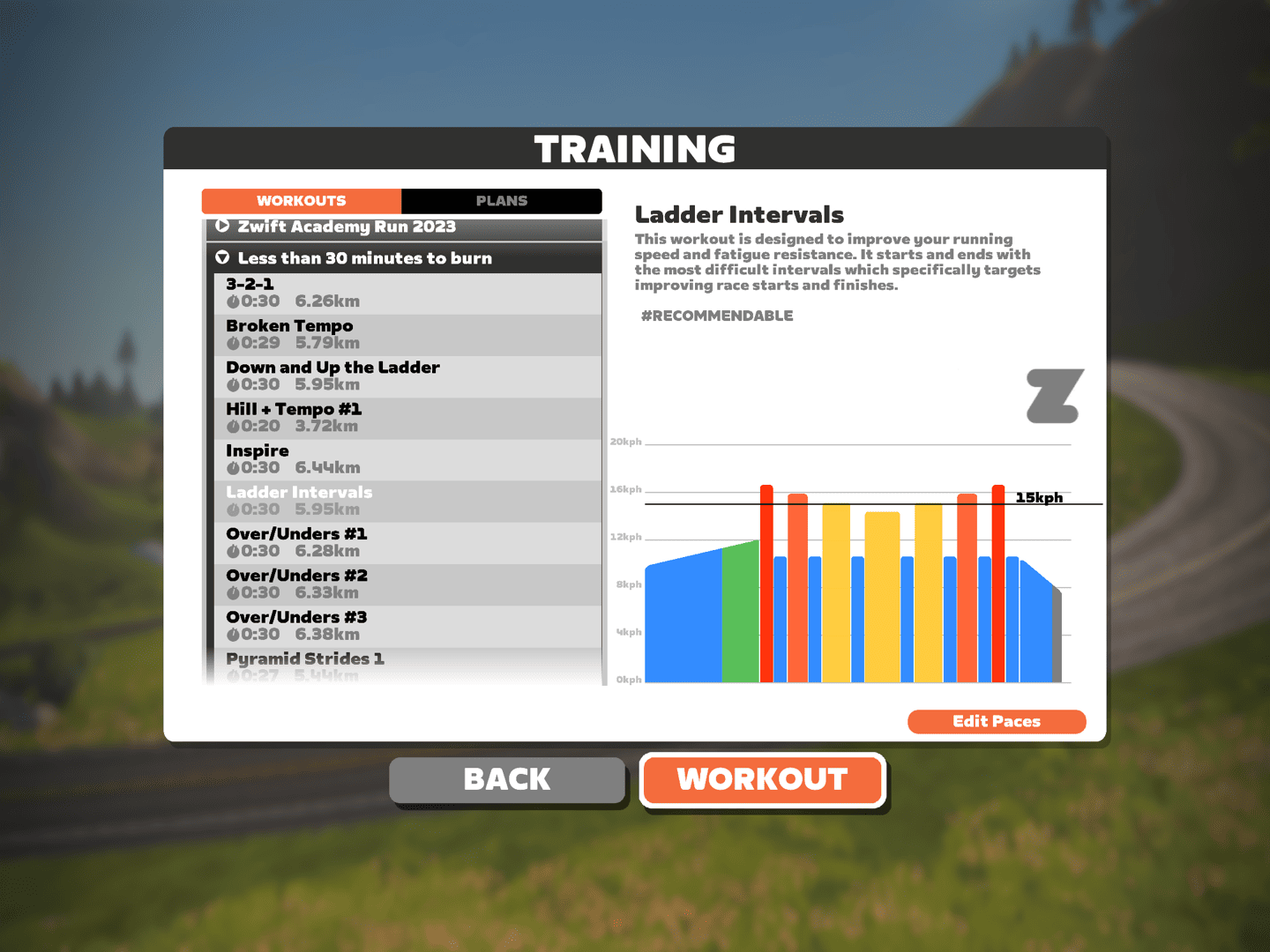
From a connectivity standpoint, I had no problems following a firmware update last winter. Prior to that, I did see dropouts from time to time, but I haven’t seen those since. It’s also worthwhile pointing out that unfortunately the Technogym MyRun only supports a single concurrent Bluetooth connection. Thus, if you wanted to transmit to Zwift, but also record that on your watch (of any brand), you can’t do that. This is likely the usage of an older Bluetooth chipset which doesn’t support multiple concurrent Bluetooth Connections. Likewise, because they don’t support ANT+ on the MyRun, you can’t leverage that either to work around this limitation.
The reason you’d want to get treadmill distance/pace into your watch is that most watches will calculate Training Load and related stats. While those stats are generally based on heart rate (or cycling power), that doesn’t mean you want inaccurate/missing data for the running portions. So that is a bit of a gap that I had to essentially solve for using other sensors (or, just accepting less-accurate wrist-based pace/distance data).
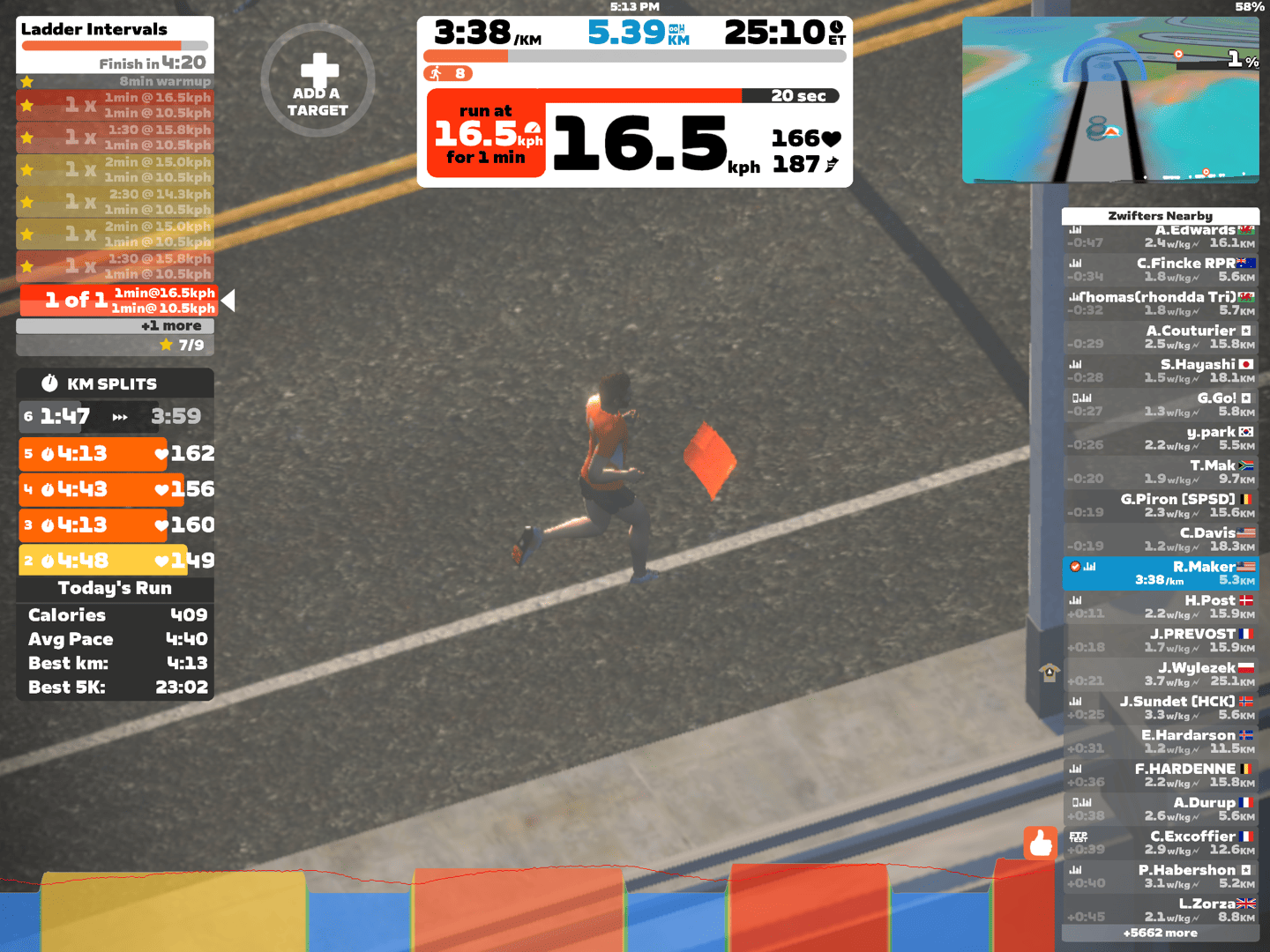
Also note that when in Zwift mode, there isn’t any recording of the data to the Technogym app (in fact, you have to have it completely closed out). Again, not a huge limitation for most, but something worthwhile noting.
In any event, the Zwift integration worked well, even if it lacked changing the incline. And again, once I had the firmware update from last winter, it worked without issue connectivity-wise.
Accuracy and Responsiveness:

When it comes to accuracy on a treadmill, I’m using three devices/tools to validate it. The trick though, is that not all of these tools are created equal. Instead, I’m basically trying to proxy for accuracy by committee. That can have its disadvantages when a single device is correct, and the rest are wrong. But in this case, I use these same devices on other treadmills as well as outside – so I’ve got a pretty good established baseline.
In any event, here’s the comparative data sets/devices:
– Stryd V3 footpod
– NPE RUNN Treadmill Sensor
– Garmin HRM-PRO Plus (indoor running mode)
This is also in addition to wrist-based watches that have estimates of pace. I’m not including that data in this review, though I did collect it. Merely because it’s often kinda variable. That said, it can provide a good tie-breaker in some cases, and can often be better than some well-worn gym treadmills that haven’t had belt maintenance in decades.
In the case of the Stryd/NPE/HRM-PRO Plus sensors, they were connected to watches that were physically strapped to the treadmill, thus ensuring they were not using wrist-based detection at all. It was purely from those sensors. In addition, I also had some watches on my wrist – the Suunto Race and Polar Vantage V3. I’m not really going to focus on that data in this review, and instead save that for their respective in-depth reviews. Merely to not muddy the waters too much with too many chart lines.
For the data here, I’m going to focus on two main data sets – one from last winter, and one from just yesterday. All on current hardware/firmware as of their respective times. I’m picking ones 8 months apart partially because I could easily find/compile those sets, and partially to show if there’s any drift/etc over time that might need looking at.
First up, let’s start with the set from yesterday – as it’s really easy and clear to see things on. This was a standard ladder/pyramid workout. An initial warm-up, and then a set that started fast, got slightly easier in pace (but also longer), before getting faster again. Here’s roughly what it should look like:

I then added an extra two intervals to the end of the planned workout, to demonstrate some speed responsiveness bits. So, here’s the speed as recorded by all the devices noted above. Here’s the entire workout, but for this section, I’ve highlighted a point during the warm-up, and you can see that the speeds are very close there (around the 5-6 minute marker). Here’s the data set:
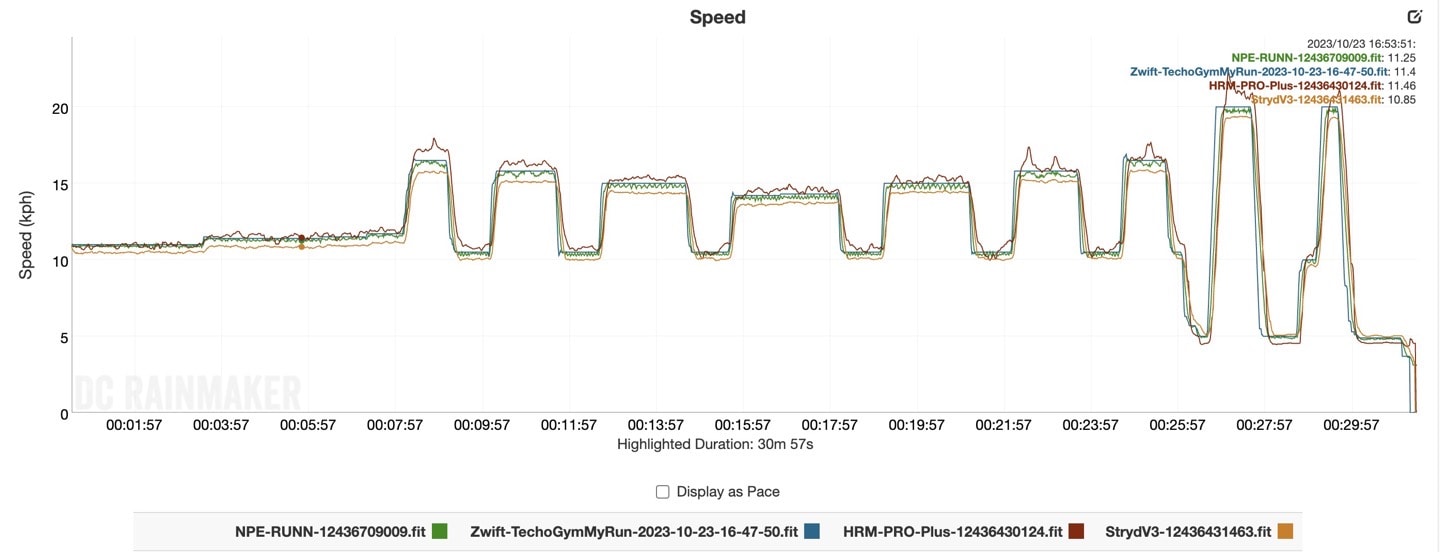
It’s important to understand that the Technogym MyRun does not show actual speed, rather, it only shows/reports the set-point speed (the speed you told it to go). This means that when I adjust speeds, the Technogym appears to ‘instantly’ switch from 10KPH to 16KPH, but in reality that takes time to ramp (else, you’d have flown off the back of the treadmill from the jolt). You can see that ramp in the graphs below.
In any case, to break out those speeds in the chart during the warm-up, at that moment in time they show:
NPE RUNN: 11.25KPH
Technogym MyRun: 11.40KPH (5:16/km, or 8:28/mi)
Garmin HRM-PRO Plus: 11.46KPH
Stryd V3: 10.85KPH
Again, there’s no guarantee any of these are right. But, I do find in general that the NPE RUNN tends to be very accurate – thus, it’s the proxy I’m most looking at alignment for.
So let’s zoom in a bit. This is fascinating, because the NPE RUNN treadmill sensor does a really good job of demonstrating the pulsing that treadmills do, as it deals with weight and my position on the treadmill. As a runner you won’t even notice this, but there are slight speed variations seen here, which are shown by that up and down of the speed by that green line. We see on this interval that the Garmin HRM-PRO Plus is now measuring higher, while the Stryd V3 continues to measure quite a bit lower.
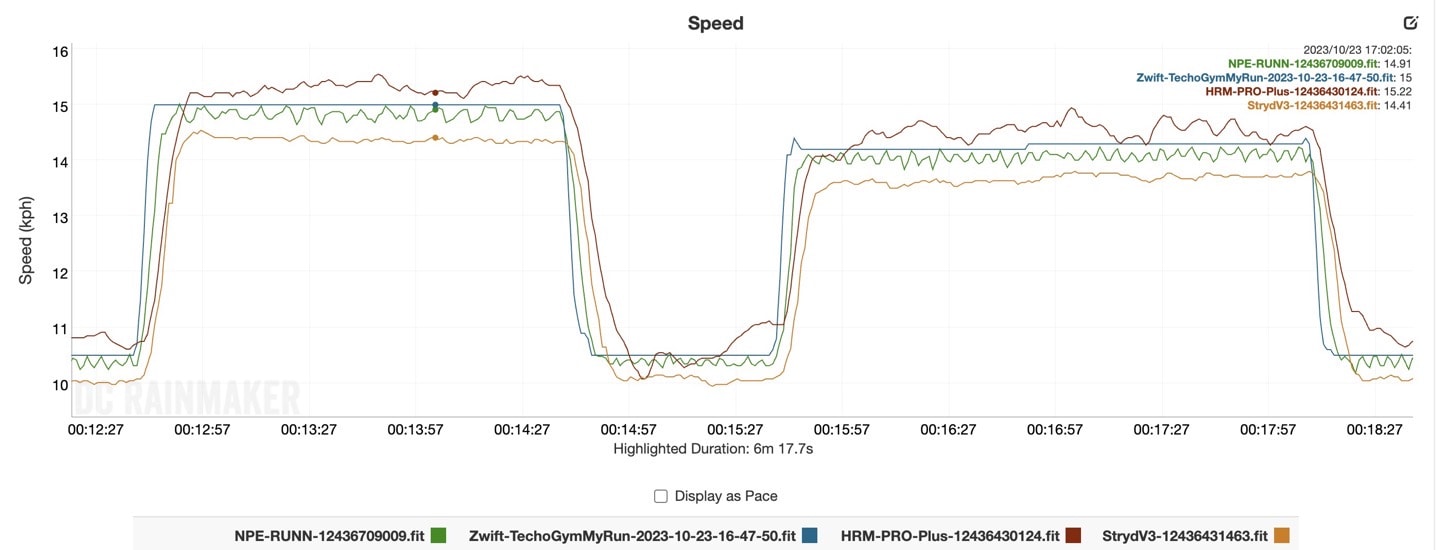
Now, as expected, the lower the speed, the more ‘together’ all these units are. Yet, the higher the speed, the more they spread apart. Check out these three higher-speed sections here:
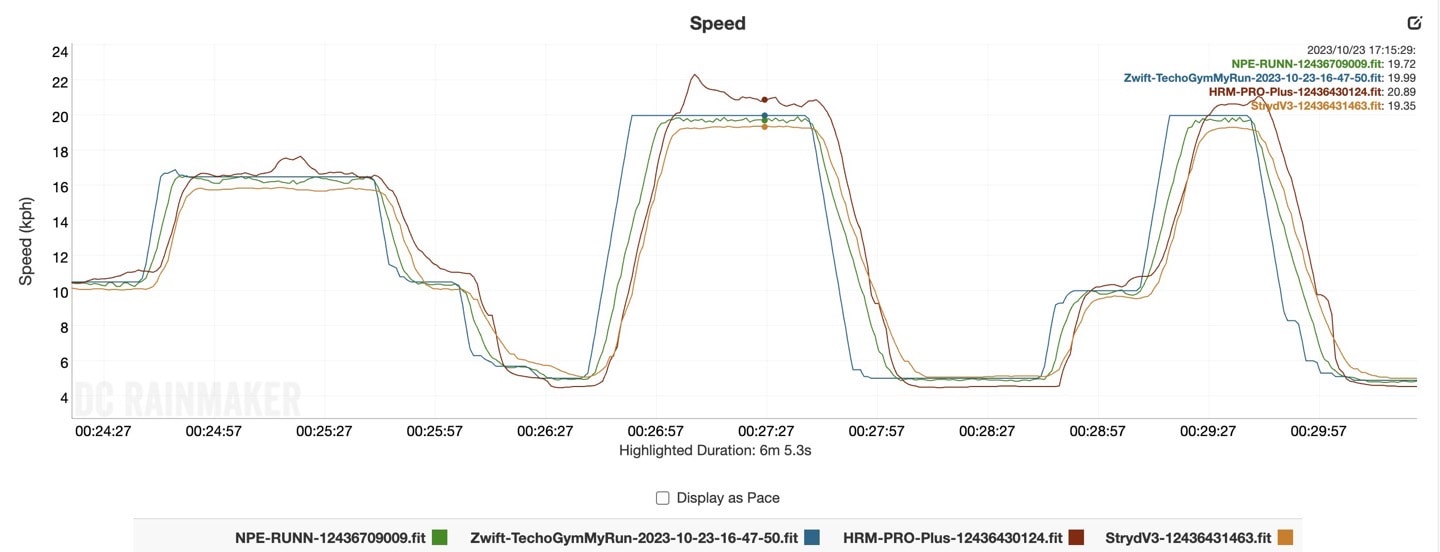
In this case, here’s those top-end reported speeds after it stabilized for a bit – before it dropped down. You’ll note that the Garmin HRM-PRO Plus did seem to bump a bit higher for some reason briefly
NPE RUNN: 19.72KPH
Technogym MyRun: 19.99KPH (funny, it didn’t report exactly 20.00KPH)
Garmin HRM-PRO Plus: 20.89KPH
Stryd V3: 19.35KPH
For me, I’m OK with that accuracy of those top speeds. I’m also happy to see that it’s not fluctuating a ton in terms of actual speeds. My older ProForm 1250 treadmill’s motor simply isn’t powerful enough and it often fluctuates at high speeds by a considerable amount, up to a couple of KPH. That’s a ton!
For context, here’s the specific structure I did above, per set treadmill speed:
#1: At 16.5KPH (3:36/km or 5:48/mi), ramped from 10KPH (casual running)
#2: A 20KPH (3:00/km or 4:50/mi), ramped from 5KPH (walking)
#3: At 20KPH (3:00km or 4:50/mi), ramped from 10KPH (casual running)
In other words, my goal here was to figure out the exact ramp times for each one. But also, to see how much different it was at higher speeds. So, from a ramp standpoint, here we go:
A) From 10KPH to 16.5KPH: ~10 seconds (recovery running to medium tempo)
B) From 10KPH to 20KPH: ~18 seconds (recovery running to hard sprint)
C) From 5KPH to 20KPH: ~23 seconds (recovery walking to hard sprint)
For the above durations, I used the NPE RUNN treadmill sensor as a way of knowing when exactly the treadmill belt actually reached the set-point speed. Inversely, I didn’t see any difference in ramping back down (slowing down) timeframes. They appeared virtually identical.
So, let’s look at that other workout from last winter. This is a longer workout, about 80 minutes long, that was heavily steady-state, with some sprints tossed in because…I have no idea why. Because someone thought it’d be fun I guess (spoiler: not fun). Here’s that data set:
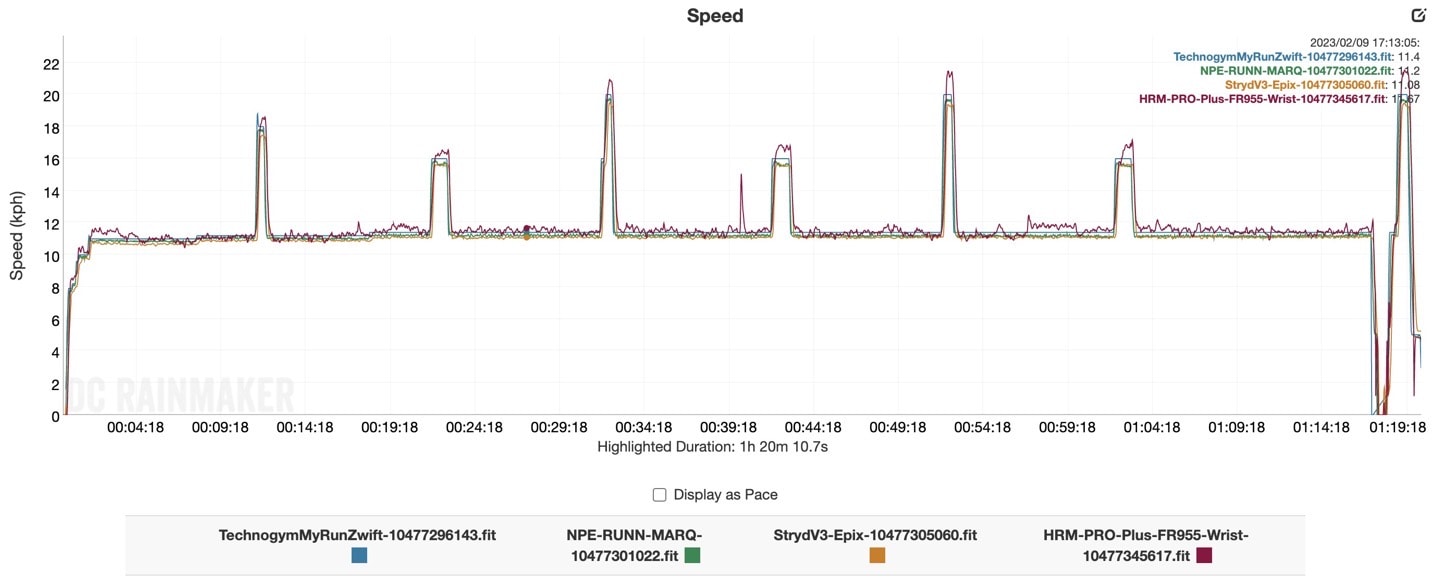
So, looking at a few pieces, here’s the last steady-state section, to see how the paces compare. Keep in mind here that the vertical scale on the graph is *MUCH* smaller right here. So you’re looking at a variance of +/- 0.1KPH from the NPE RUNN/Stryd units. The Garmin HRM-PRO Plus has a higher variance here of +/- 0.3ish. The Technogym Treadmill continues to report only the set-point, not actual speed.
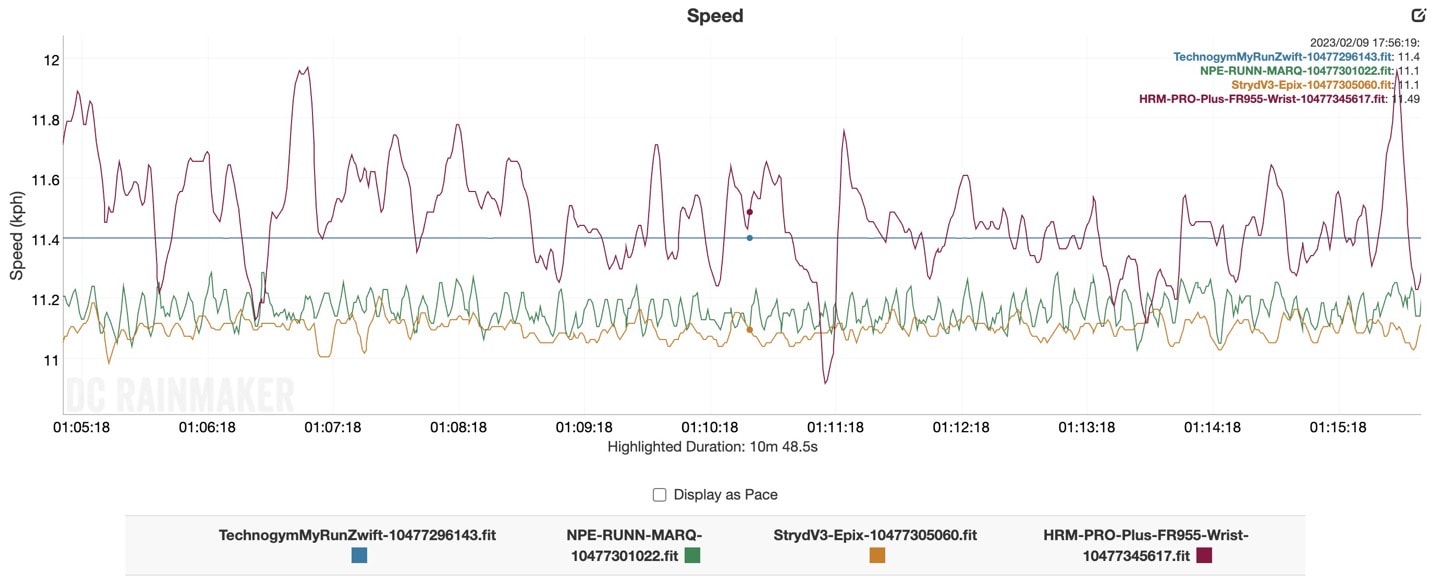
I thought it was interesting/notable that the Stryd and NPE RUNN were much closer here last winter, than now (across this entire workout). Make of that what you will. Does that mean the treadmill is slowly drifting? Or does that mean Stryd is slowly drifting? Or does that mean some combination of them? My guess here is that above, the difference between the treadmill and the NPE RUNN is only 0.1KPH, versus Stryd is considerably further apart now. Thus, my guess is Stryd is slowly drifting. But that’s probably a topic for another day.
Instead, here’s a sprint. We see here the same/similar ramp rates as previous, because these intervals happen to be in the same ballpark.

And looking at those values at the mid-point of the interval we see:
NPE RUNN: 15.64KPH
Technogym MyRun: 16.00KPH
Garmin HRM-PRO Plus: 16.18KPH
Stryd V3: 15.56KPH
Ultimately, I’d say that both in terms of what I see in these two sets as well as 18 months of sets, I have no problems with accuracy on the Technogym MyRun. It seems within reason of what I’d expect and lines itself up pretty nicely compared to the NPE RUNN treadmill sensor, which I find to be one of the most accurate proxies for treadmills, as it’s literally measuring the belt itself. It splits the difference between the Stryd V3 (lower) and the Garmin HRM-PRO Plus (higher), which are both using accelerometers and gyros to estimate pace and speed.
While Stryd has often talked about how treadmills aren’t as accurate as their footpods, due to speed changes within each footstep (because the belt gets weighted down), that doesn’t change the reality that the NPE RUNN correctly captures the total average time between each of the numerous markers on the treadmill – thus distance is then calculated correctly as well (irrespective of tiny fluctuations between it).
(Note: All of the charts in these accuracy sections were created using the DCR Analyzer tool. It allows you to compare power meters/trainers, heart rate, cadence, speed/pace, GPS tracks, and plenty more. You can use it as well for your own gadget comparisons, more details here.)
Wrap-Up:
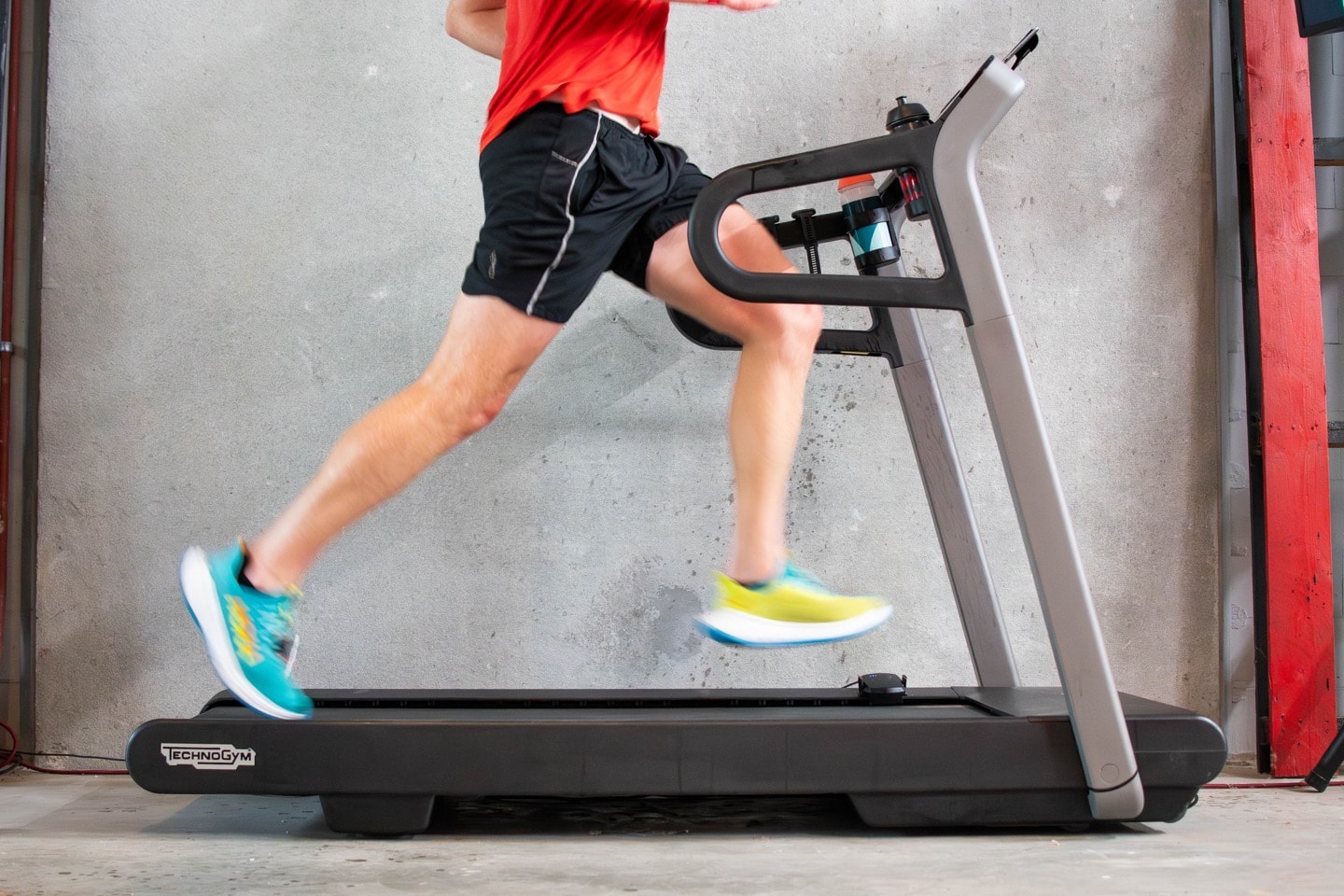
Over the last 18 months or so, I’ve been asked many times what I thought of it, and how it compares. And my answer has always been the same: It’s a great little unit that seems to edge on overpriced – at least for the US market (the Euro market is more complicated, as I’ll explain). Specifically, at $4,050USD/€3,500, it’s on the higher end of the spectrum for mainstream consumer treadmill prices. Sure, there are always higher-end ones that offer something extra, but that’s not this unit. Likewise, there are always cheaper ones that have a struggling motor, reduced specs, or less durable components. Also, that’s not this unit.
A common comparison a lot of people have asked about is the Peloton Tread I bought a couple of years ago, which is priced at $2,995USD/€3,795. That’s a very different treadmill in terms of fancier features. Namely, it’s got a big brilliant screen, more controls, and has an optional subscription component. But to be clear, that subscription is indeed…optional (just like the Technogym App subscription is an optional subscription, at 8.99EUR/month or 89EUR/year). If you just want the same core treadmill portion that the Technogym MyRun has, then those baseline speed/incline/specs features are nearly identical between the two treadmills. Thus one can see why so many people keep asking for my comparison between the two units. Especially given the Euro pricing is nearly identical (of course, at present, Technogym has far greater country deliverability).
However, the biggest technical advantage the Technogym MyRun has is direct integration to Zwift (which Peloton lacks entirely), in terms of transmitting your speed via Bluetooth Smart. That’s very useful and has a very high “just works” factor. But notably, you can also add that to a Peloton Treadmill using the NPE RUNN for about $100 (a relatively trivial sum after spending $3,000+ on a treadmill). And in that case, it’ll even give you the correct exact paces during speed ramp changes too. Now, if Zwift and Technogym had done proper integration of controlled pace and/or incline into the Technogym MyRun (which Technogym says they are very open to), then that’d be a huge selling point.
The other area the Technogym lacks is customizable hardware presets for speed when used with apps like Zwift. For example having a preset configured to a certain interval speed, versus having to hold the paddle up/down the entire time. Sure, if you use the Technogym app to create a workout then it controls it automatically (which is awesome), but creating an interval workout on their app will likely take years off your life, due to how frustratingly bad it is. While I’m not a huge fan of Peloton’s screen-based speed presets (due to the messiness of tapping a tiny area of the touchscreen while sweaty running mid-interval), at least they exist. It’s the one area I actually prefer my older ProForm treadmill with its silly TI-82 calculator-style console of a dozen preset buttons. A case of function over form.
I bring all these comparisons up because that’s real life. If you’re looking at buying a treadmill, you’re comparing products. When I mentioned the Technogym MyRun was going back to Technogym (it was just a media loaner), my wife audibly said “Aww, I liked that one”. And it’s true. Both of us liked it. There’s a simplicity in Technogym’s design that makes it really appealing, both from a visual hardware standpoint, but also a functional standpoint. Simply stand on it, tap and go. Zwift then does it’s connectivity magic, and life is great.
Point is, Technogym has made a great little treadmill. Sure, it could use some very minor tweaks, but on the whole it’s a great unit that’s worked well for us over the last 18 months. The data appears accurate to me, and the stability of the hardware and connectivity has been solid. How that fits into other competitive options for your specific needs is a trickier question for me to answer, but hopefully this review gave you the details you need to sort that out.
With that, thanks for reading!
FOUND THIS POST USEFUL? SUPPORT THE SITE!
Hopefully, you found this post useful. The website is really a labor of love, so please consider becoming a DC RAINMAKER Supporter. This gets you an ad-free experience, and access to our (mostly) bi-monthly behind-the-scenes video series of “Shed Talkin’”.
Support DCRainMaker - Shop on Amazon
Otherwise, perhaps consider using the below link if shopping on Amazon. As an Amazon Associate, I earn from qualifying purchases. It doesn’t cost you anything extra, but your purchases help support this website a lot. It could simply be buying toilet paper, or this pizza oven we use and love.

















When I was looking at getting a new treadmill, I was talking to folks with these. When I watched them using, it shook a lot.
So for me the best thing I have done is buy 4 used Life Fitness Club treadmills. Over 400lb, so they do NOT move when running, even fast. And since I can connect a GEM module on each of these and run on Zwift run, for around 1K each, going used is the only way to go, IMO.
Never makes sense, IMO, to buy exercise equipment new. Best time a few months after New Years. :)
Nice review, Ray! By chance, have you ever used it with Kinomap? My guess is it works fine there but would be interesting to hear a perspective.
I looked at the MyRun in 2020 as the pandemic was raging and Apple had started their Fitness+ service, and at the time, I was disappointed that it did not support GymKit, as Fitness+ tread classes can bring in data on screen with that protocol. Now I’d just prefer for Fitness+ to support FTMS and hope that’s on the books for next year. I ended up deciding having an indoor cycle and rower for my home was enough and I reserve my running for outdoors only. The MyRun is pretty much top of my list if I ever change my mind though.
Also I’m kind of surprised other tread makers haven’t woken up to the advantages of not having their own integrated screens and instead let the user bring their own iPad. The clean look of the MyRun is in start contrast to the clunky looks of pretty much everyone else.
Thanks!
No, unfortunately, I hadn’t tried it with Kinomap.
I agree that a clean-look works well for manufs, and would seem to lower the cost considerably. I’d have to assume that TechnoGym’s margins are far higher than Peloton’s, given the lack of hardware required for the MyRun (and that even ignores that Peloton undoubtedly spends more to put the motor below the deck, versus the more traditional design of the MyRun).
I also agree that the landscape of standards is so close, but still kinda cobbly. For example, the Technogym MyRun having FTMS is great, but not having any ANT+ (or dual-BLE, or just BLE footpod), limits integration with watches considerably. And with most serious runners having some sort of sports watch that could leverage the treadmill, that’s a bummer.
I guess the margin is massively influenced by the quantity that is built… no idea whether those two units are in the same ballpark.
Similar to the other question, I was wondering if you tried the Technogym MyRun with the Kinni app?
Their website says it will control this treadmill but if it doesn’t use FTMS I’m wondering if that is accurate.
At least workout creation would be easier with Kinni.
I was disappointed that my Nordictrack Commercial 1750 wouldn’t work with Kinni.
I haven’t tried Kinni. The Technogym does FTMS, but my understanding from Technogym is that for the control piece, Technogym has to approve/certify it (a reasonable request for control of a treadmill). Perhaps Kinni has gone through that, I don’t know.
Kinni cannot control the incline or speed of the MyRun either – i’ve tested it. When you connect the app to the treadmill you get a warning about FTMS standards… and then the incline/speed buttons in the app are greyed out.
One thing Ioved about getting my myrun nearly 5 years ago was the interest free payment plan technogym had with santander. Not sure if that is still an option but it made it very attractive to us back in 2019. As for sound in the living room, my huffing and puffing and grunting was louder than the machine but the tv was very easily heard when I use it. The safety clip is also super useful for me as I use that when im done and hang it on the wall up high so toddlers cant get hurt on the machine
Yup, good point on putting the safety clip somewhere…safe, for ensuring littles don’t use it.
Nice review.
As a general methodology for treadmill accuracy testing, I would not recommend the NPE RUNN sensor. While this sensor is pretty accurate in measuring belt speed, measured belt speed may not be your actual run speed.
This is because – unless you have a very high end treadmill – the belt speed is not constant during the « in air » and « contact » phases of your run.
Indeed, the belt tends to move slightly slower when your foot hits the ground, and accelerates when you’re in the air. Your actual run speed is only the belt speed during ground contact, not the belt speed during the aerial phase. Hence, when there are variations in belt speed during the cadence phases, your run speed may well be overestimated with the RUNN TPE.
This difference will generally get higher during high-speed intervals, as the engine gets closer to its maximum power. On my treadmill a 1 to 2kph difference between « measured belt speed » and « runner speed » is not unusual, so I always use the stryd as a reference. My runn tpe is actually pretty useless.
Your explanation is something that Stryd repeats many times as to why Stryd is supposedly better on a treadmill. And while there are some foundations of truth to what they’re saying, the reality is that the NPE Runn is measuring those speed gains/losses too. You put more dots, and it captures more data, that’s why I do. In fact, I even talk about it in the post, and show (zoomed in), those fluctuations. But, the cool part of recording more data is that it’s capturing more data, and thus dealing with those averages.
Likewise, I also have the older TreadTracker, which does the same thing, and I showed it back then too. In fact, I even went down an entire crazy rabbit hole of connecting up running course measuring devices to the treadmill to capture data: link to dcrainmaker.com
Haha I might sound like a stryd employee then (which I’m not by the way, lol)
Even with more NPE data points, half of them would simply be useless for training purposes if your treadmill has large cadence-related speed variations (which does not seem to be the case with this treadmill, as per your graphs).
But as I’m writing this comment I now see your point about using the NPE data to assess the treadmill’s ability to hold a constant speed.
How do i connect a Garmin Epix Gen 2 to the BT FTMS Channel?
I have access to several Woodways and Ray, you know that problem ;-)
Has anyone gotten a substantive update from Woodway recently? NPE said the GEM2 could output as a footpod, and that the OEM could enable that function. Woodway has said that they are exploring this, but nothing concrete.
I find the best way to use the treadmill is to connect the treadmill to my garmin watch, then use the virtual run app on my watch to connect to zwift. This way, I get accurate data to both the watch and zwift while only using 1 bluetooth channel on the treadmill.
Overall, I’ve had the treadmill for over two years and have been very happy with it.
Does Garmin get the incline data in this setup?
Thanks for the review Ray. If you’ve returned the unit, then guessing you may not be able to answer this (but maybe someone else who has one can)…
What height of space would you need to practically use this without smashing your head into the ceiling? I appreciate that’s going to be dependent on runner height, running style etc, but any kind of ball park would be good. I’m questioning if a garden office, which isn’t particularly tall) would realistically accommodate something lie this (and if not, is there anything anyone knows if that has a profile that’s even lower to the ground?)
Thanks for the review Ray. Can you clarify the status of Garmin watches receiving treadmill data over BLE FTMS? I have an Instinct Crossover and I thought I could connect to machines like the Concept2 RowErg via FTMS, but not treadmills.
I thought Garmin connected to Concept2 by ANT+ FE-C and not Bluetooth FTMS. I’m under the impression Garmin doesn’t do anything with Bluetooth FTMS but happy if that’s inaccurate.
Raven, thanks, you are right, my mistake.
Great to spot the Laka bidon!!
May I know what is the width of the running map?
The runnable surface of this belt measures 143cm/56.3” long, and 50cm/19.7” wide.
Hi Ray,
thanks for writing this up!
Given that there’s no direct treadmill control from Zwift, would a better option for Zwift running be a “cheaper” treadmill + NPE Runn?
Yeah, I think that’s probably the elephant in the room, especially if it’s not a small room and space (or swanky design) isn’t a concern.
If Zwift/Technogym were to work together on control, it’d be a very strong “duh, get this treadmill’, but without that, the world is your oyster with NPE Runn (or even their GEM module if you can find a treadmill that supports that). I cover that module concept here, before NPE bought it back from Wahoo: link to dcrainmaker.com
The question is what is better to choose. Treadmill or access to the gym for 5 years. This is what about the price :P
True, really then a trade-off of time vs convenience. As always, gym’s usually have more equipment, sometimes classes, etc… But in some gyms, that equipment might be time-limited (often, especially treadmills are actually, sometimes just 30 minutes).
And then there’s time to travel to/from a gym, etc that can all add up. I think for “a runner”, as in, someone that’s been running many years, and likely to run many years, and has structured training, runs at number of times per week, etc… then having their own treadmill (versus a gym one) makes a lot of sense. Whereas if someone tries to avoid the treadmill at all costs (somewhat like me, to be honest), and/or lives next to a gym with good hours/treadmill availability, then it makes more sense to have a gym membership as required.
I agree with you. Compromise. If you have the room, the gym is far away and the noise doesn’t bother you, you should buy it.
I have a gym 500 m from my house. There are always days off. There are no time limits. I have a bike and a trainer in my room, but I would get rid of them if the gym had road bikes with Zwift. I won’t be able to do the training I want on fitness bikes. The treadmill in the room is too much space and the worst thing is the noise. The treadmill itself is not noisy, but when you try to run above 12-18 km/h, your feet pound loudly. It’s best to have a separate room (garage) with ventilation! Then you can think about your own treadmill.
Going to the gym is a great question. The problem with a gym, the treadmills and the bikes especially are second rate. I think virtual cycling and running is an addition to your current set of sports and intellectual activities. Thus, you have to throw money at the problem. Gyms are complicated because of the social experience. If you are a tennis member at a top club, it is a positive experience. Golf memberships are social, and that is the key to Golf, it is not necessarily athletic. Weight rooms are great because there is no maintenance of analog equipment, and now digital equipment has been introduced at most YMCAs and they have proliferated an electronic weight lifting platform that works for older people based upon eccentric over concentric loading. The leader in virtual exercise moving forward by far is going to be Golf because of TopGolf and competitors that intend to bring spatially localized socialization to the virtual market. There is a clearly successful profit model, the basic setup is that anyone can show up and try it out, the social interactions are fun and exciting to those who know nothing about the sport, and the barriers to entry involve a credit card, a beer, and pub food. That’s not my idea of a good time, but realistically, I have had little success encouraging friends in my social network beyond hardcore athletes to exercise with me. And all of my hardcore friends, mountain bikers and skiers, they are not into virtual training,
We have had two of these in our home for what must be close to 5 years now, regarding sound your feet hitting the belt/deck is loudest sound, motor sound is far lower and in fact the fan you are likely using with it will make more noise. I am 193cm and just under 100kg, and I was worried about the more compact deck size but it hasn’t been a problem. The key feature for us has been that Technogym offers extended service contracts for the units, so they get regular maintenance and when parts have broken (a couple of their older design motherboards started throwing errors) the fix was fast and covered by the service agreement. We use them in dedicated AppleTV Zwift setups with 43in TVs on a media mount and the “it just works factor” is very high.
Very nice setup.
I switched out my Apple TV for my MacMini M1. I think the Zwift experience is far superior in high definition, and I think the MacMini M1 is still underpowered. I think the industry reference standard for visualizations is 4K/60 frames per second with no tearing. I like your setup, right in front of a window. That’s the best setup, because it creates a visual cue of engagement. I think Zwift should be encouraging all users to upgrade from the AppleTV, as it is a dead end that is going to be challenging to maintain. MyWoosh is scaling on x86 and has the UCI contract, doubtful they will do running. Having said that, the future of virtual exercise has to involve superior visualizations.
I also have the extended warranty, which I’ve used a number of times as the motor belt stretches reasonably quickly but after roughly 18 months & 2k kms the running belt and deck now need replaced, as the belt is stretched & the deck is rippling, which Technogym say is a “wear & tear” issue & thus NOT covered by the extended warranty I purchased.
This is ~£750 repair!!! And of course will be required again in another 2k. By then who knows how much that will be.
This has now certainly made me regret purchasing it!
Why does it look like you are running in plastic “room” in the garage? Do you have your training area sectioned off or something?
He mentioned it’s for heat acclimation training which they were doing for Kona.
Ah that makes perfect sense. Thanks!
Technogym: Uhhh yeah, DCR, are we ever going to get that media loaner back? It’s been, what, like 18months?
DCR: Oh sh*t! Better do that review!
Love it, I was one that asked for a Zwift compatibility with this trainer a bit over 18 months ago. Don’t know that it would’ve changed my mind, as I chose a treadmill that transmits to Zwift and is better suited for sprint intervals.
I was just being…thorough. 😂
That said, my relationships with treadmills is entirely heavily weather dependent. I can go half a winter and avoid them, and then will get a month of Dutch hill and won’t dare step outside.
I’ve been looking forward to this review. I bought a MyRun around 5 years ago and sold it around 4 years ago after realising (a) how much I hate indoor running and (b) how frustrating the old app was. The hardware was great, as was Zwift integration, but the app was virtually unusable. It felt like Technogym just didn’t care about this and, although the apps you reviewed are the newest ones, it doesn’t sound like much has changed here. Such great hardware let down but such poor software.
Great review. I’m currently happy with my 15 year old Life Fitness T3O plus the NPE Runn with a 32″ tv running an Apple TV with Zwift. Someday I would like to replace with a treadmill that is controllable by app. Probably wait for the LF to die. I had to replace the main board on the motor a couple years ago with a rebuilt board and parts just aren’t available anymore so that could be sooner than I’d like.
A great book to read is “Haptics” by Lynette A. Jones. It is a MIT press essential. It should be required reading for anyone in this industry, along with reading about the financials of these companies on a regular basis. Modular control of the running units through a separate wireless connection will be extremely hard for two reasons. First, the modules on an existing treadmill are going to be legacy. Second, this is an area of haptic response, and that includes incline. If you have access to an Assault Runner, you can get a sense of the analog nature of this device on Zwift, it is direct display of speed which varies through your running, thus the device is able to provide immediate haptic feedback of the runner’s foot effort. With a cadence monitor on a Garmin or with the Zwift pod, you can get true cadence feedback, and with the Garmin, you can get heart rate. But the incline and speed of the surface are haptic, it is a variable kinesthetic feel, and that is the challenge. In biking, a single bike trainer to my knowledge provided Haptic response, and that was the TacXNeo2T ‘road feel’ and the results were impressive, but rejected by the market. In video gaming, Haptics have been achieved primarily on the PlayStation controllers, the dual shock. XBox is going to release a Haptic controller in 2024 apparently. If you look at the financials of treadmill companies, it is a train wreck. Look at LifeFitness, then look at Zwift, the financials are extremely distorted, and cannot deliver on technology promises. This is stark contrast to Apple and Meta which consistently delivers on technology features because of the size and the depth of the market. I think the area of indoor virtual training is still early. We know that women prefer the video feed encouragement model as pioneered by Peloton, convenience over quality, and that model has also cratered, and they decided to partner with LuLuLemon as the enterprise value is not about fitness per se, it is about merchandise. Problem with the running trainers, hard to sell merchandise despite a captive audience. Compare that to TopGolf, here you have people on a Friday night, they are going to meet friends socially, they sit down, everyone swings the clubs, people literally miss the ball, no problem, people servers are delivering beer and food, basically consumable merchandise, and that profit model is driving re-investment into computer servers, technology upgrades of launch monitors, radar, visual enhancements, paying programers, and also improving the in person experience. To my knowledge, despite tremendous interest and effort, not a single virtual platform in biking and running can deliver on the in person social experience, including Zwift Academy, because it is simply not how most road bikers and runners socially relate. If you look at Zwift in biking, the data from the computer to the trainer is sending resistance in real time, and on any real bike, connected to that cassette, haptic response has been achieved, that was the key innovation. Beyond that, I have mentioned visuals is going to be the next innovation along with variable short pitched routes. Running on 4K/60FPS on a MacM1, it is actually an extremely representative experience, not perfect, but almost there, and worth the upgrade from the Apple TV. In the area of visuals, Zwift has plenty of growth on the AppleMacOS or PC platforms outside mobile, and in the area of haptics, device control, Zwift has almost zero growth potential, because it is literally one of the hardest nuts in technology to crack.
Had mine for 3 years and absolutely love it. The minimalist design is great and I’ve never had any connection issues with iPad, Garmin Watch or Apple Watch (Zwift could learn a thing or two from Technogym here).
As always, great review!
If you have any contacts at Peloton perhaps they should investigate an alternative to their classes and have a “Zwift channel” for both bike and tread. They could still control their source but broadcast speed, cadence, HR etc. I am not sure though on the bike if their broadcast of power equates to others such as Wahoo, Garmin, Watt, etc.
Now this may not be Peloton’s intended business model, but maybe they have just never thought about it.
Thanks, Ray
If Peloton were to do this, then it would still require their All Access subscription at $44/month. They’ve been experimenting in betas with putting things like Netflix, Disney+, and Hulu as things to watch while you use their machine, but those features won’t work without an active subscription.
That is true, but you’re gonna be paying that anyway, if you want to use all of the Peloton classes.
By offering both, you can have the best of both.
Thanks, Ray, terrific review as always. We’ve had ours for 6 months, and totally agree with your assessment. The single channel Bluetooth is annoying at this price point, and I’ve had a few Garmin watch drops, but those are small items for what otherwise is a great device. In some respects it sits in its own market segment; a small treadmill that can charge a price premium because it has a somewhat open / interoperable platform, a great design, and above average quality. The Peloton isn’t much larger by the numbers, but it “feels” much bigger because of the huge screen. Plus, as one of the commentators noted above, they have a very strong (if, again, expensive) long term warranty. Really a shame it costs so much, but we ultimately needed something that could fit in a small space. Now let’s see if Technogym has improved the accuracy (and interoperability) of the bike that you originally reviewed a year or two ago. If they have, that would be crazy expensive but nonetheless compelling “it just works” combo for the tri family with money.
Our experience is that the Wahoo Kicker Bike is the correct “stupid expensive but just works” solution over the Technogym bike. With the right generation you get tilt, steering, brakes…a lot of features along with massive adjustability and near-zero maintenance.
I have the extended warranty and am facing a £750 repair price for a new deck & running belt, which isn’t covered as considered “wear and tear”. The technician says this is normal after around 2000km. So it certainly works out as a pricey treadmill if being used frequently!
An interesting comparison might be the Horizon Fitness Omega Z Folding Treadmill, which I have recently purchased in the UK (at an absolute bargain price I might add). Looks very similar in form factor, possibly a little bigger, but can fold up. Doesn’t have the the TechnoGym app obviously, but I’ve been pretty happy with the automatic Zwift integration.
Great review, could you also share the details of the heat chamber? I’ve been searching for one.
Yup, working to write something up on it.
In short, a 80€ trip to Gamma and 20€ worth of greenhouse plastic film from Amazon Germany. 😂
Plus one afternoon with my 5yo daughter building it.
I’m glad I’m not the only one who notices a lower speed on the Stryd V3 versus the NPE Runn. I have a True 950 treadmill and it’s awesome. The NPE Runn mostly agrees with the treadmill, and you can see that the treadmill will average to the setpoint with small oscillations around it, typical of motor controllers. Lubing the treadmill belt with quality silicone oil will eliminate the jerkiness experienced on foot strikes.
Why aren’t there treadmills where the front bar can be set to a low height? That way you can have a full treadmill to run but also able to fit under a standing desk to walk during work. Seems like you have to have two treadmills if you want that functionally
Not to be controversial, but I disagree re 20kph being fine for all but short distance runners. Sprints help build running economy which helps at longer distances (not plucking this out of my backside, source):
link to scienceofultra.com
For a decent chunk of runners, 3:00/km (20kph) is not a flat out sprint. 18s 100m pace if I’ve done the maths right?
I rarely race below ultra distance and they’re a core workout for me. When I force myself to do speedwork anyway, which isn’t as often as it should be. I don’t know how common they are, but I’d be surprised if sprint sessions are reserved to very short distance runners. So I’m not sold that only short distance runners need the higher paces – I’d say it’s much more important to know what your max running speed is before picking a treadmill. Unless you know categorically that you’re never going to do a sprint session on there.
I checked before picking my treadmill and ended up with one doing 22kph…it’s not much more than my highest possible pace (about 21kph, maybe a touch under), but it’s enough that if I do a sprint session – I can properly commit. I’d have looked for a 24kph one if I could have afforded it for a bit more headroom, but having never actually hit 22kph in sprint sessions before or since, I’m not convinced my sprint speed is going to rise significantly. So 22kph seems fine for my use.
I’d love to see auto incline/pace adjust at least for workouts in Zwift, I hope they get around to taking Technogym up on the offer.
There’s been a trick to get auto incline working with a go-between device (a program running on a Pi Zero) by taking advantage of a bug in Zwift described here:
link to github.com
That said, it’s a hack, and I think auto incline in the open world would probably adjust too often and be a lot of wear on the motor. It’d be nice if Zwift had it as an option that could be enabled only for structured workouts, along with auto pace adjustments.
You forgot to mention that you can directly connect your Garmin Fenix 7 to the MyRun treadmill through Bluetooth. After I’ve connected my Garmin Garmin Fenix 7 to the treadmill I connect it to Zwift through Garmin virtual run mode and voila, I have my Garmin heart rate, cadence, and speed directly in the Zwift app. And as Garmin has running power included in the watch I also see my calorie consumption at the end. No need for any running pod, belt etc etc.
Super cool! Thank you sharing. How accurate do you feel your Garmin Fenix 7’s metrics are to what the treadmill is reporting?
I would reckon some 10-15 meters on a distance of about 4-5 km, that is my daily running distance. So not a big deal.
There is an option on the watch to calibrate to match the treadmill but I’m too lazy to do that. :)
The Virtual Run on Garmin works, I use a Forerunner 55. The heart rate is very accurate, and low latency. The speed is not equivalent to my Assault Runner, which is very accurate, and Zwift Pod for Cadence. I find that these devices are extremely useful to train occasionally. I happen to prefer running and biking outside, but this is an area of innovation worthy of exploration and study.
MyRun treadmill is just spot on regarding speed compared to my Garmin 7 Fenix but there is a mismatch regarding the distance due to not calibrating the watch with the treadmill. It’s just so cool to see my heart rate, cadence and speed directly in Zwift while running!
Very helpful review, thank you! Does anyone know if the MyRun includes a heart rate control feature that automatically changes speed and/or incline to maintain the target heart rate set by the user? Sole and True Fitness have this feature, which is really useful for Zone 2 training.
Technogym answered this for me: “the CPR (Constant Pulse Rate) system follows your heart rate and automatically changes speed or incline while you are training, in order to give you a workout that is completely tailored to your features.” Great feature for mindless Zone 2 training.
It does control speed but I’ve not managed to figure out how it controls incline unfortunately, unless it’s something obvious that I’ve missed!
I agree the workout creator is comically bad, I ended up using “speed shift” which you seem to have missed/skipped. That way the speed paddle takes you quickly between a few presets. This worked nicely for me for intervals.
Hi,
where can I set an incline in the TrainingPeaks structured workout builder. I’m not able to find this, and would like to build a workout with changing incline during an interval.
Cheers
I have a MyRun and I love it, the minimal design is worth a lot, and it is quieter and more robust than other units I have used and owned.
I use an app called QZ that acts as an intimediary between the treadmill and Zwift/Pelton etc., or as a stand alone control and data gathering system. It works very well, and exports .fit files for Garmin if you want them. QZ is definitely able to control inclination and pace on the treadmill, so it must have found a work-around for the certification you talked about.
I’m curious if anyone else has tried pairing this with MyWhoosh. It does pair, but the numbers on the display don’t stay in sync with the treadmill. Also, the runner is always moving, even when the treadmill is stopped.
Great review.
Talking about Zwift setup:
Since there is no interaction with the MyRun-app, do you even need (to buy) a tablet to use the MyRun on Zwift?
No, you don’t need an iPad running the Technogym app if you don’t want to use any of its features.
Zwift on I.E. Apple TV or PC is all you need to run. It will connect directly to the myRun via bluetooth.
I however use the Technogym app to run structured workouts imported from TrainingPeaks. This way the myRun is fully automatically adjusting the speeds for the training. In Zwift I’m just running a course at the same time.
If you do a structured workout in Zwift directly, you need to manually adjust the speed on the myRun.
Thank you for the exstensive response!
You will need something running iOS to run the Technogym app on to update the firmware on the MyRun at least initially though. Once it’s on a new enough version to work with Zwift, you won’t need it during use.
Great review. Thanks. So far like 99% of the comments I’ve read online are good, but I have just received a voice message from a gym technician saying that the treadmill is very bad and only for “elderly people” to just walk. So very strange.
My real doubt is about the weight of the user, as I am myself 85kg and my limited experience with other “domestic” treadmills is that they would stop right below my feet in the middle of my workout due to not enough motor power.
Can you give some hints about your weight and if you had any issues with the treadmill being able to push through the workout without any issues? Thanks again.
I float between 85-90kg. No issues whatsoever going to the speeds seen in my review.
I bought the treadmill three years ago. I weigh around 100kg and have never had an issue with its performance. However, I’m a slow runner and rarely go above 7mph so I can’t vouch for how it performs at the max speed.
I weigh 90kg. I’ve had the MYRUN almost 5 years and have put 1500+ miles on it. I’ve never had any issues with the power of the motor, even running intervals at over 11mph. I don’t know what that gym technician was talking about, and I’m not sure they do either. 😜
I know this is an old post, but I wanted to correct the custom workout complaint. I’m a huge fan of creating the custom workouts when I have to use the gyms Technogym treadmill. I agree the sliders are sensitive, but the little plus button at the top right works perfectly to clone each interval. If I have a 5x workout of fast/slow you create each interval once and just tap away to clone them. I used to really like the up/down lever to set auto paces but this is even easier. And once it’s created it’s selectable at the next session.